
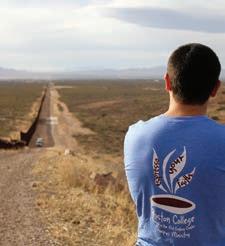
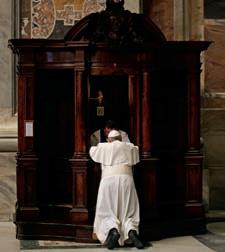

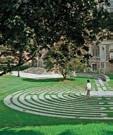
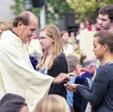

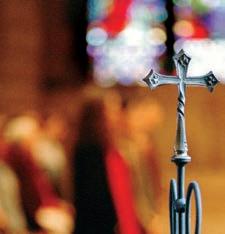









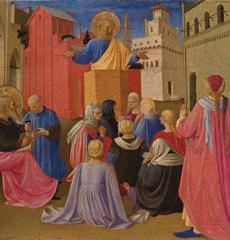






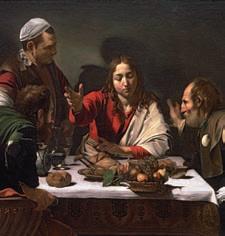
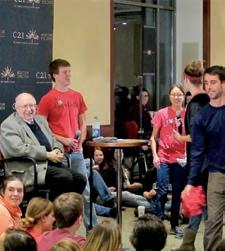

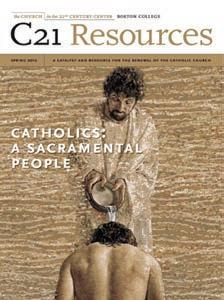
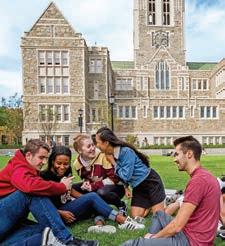





Exploring the Catholic Intellectual Tradition SeSquicentennial iSSue edited by robert p. imbelli spring 2013 Living Faith for the Journey THE CHURCH IN THE 21 CENTURY CENTER FALL 2017 A Catalyst and Resource for the Renewal of the Catholic Church FALL 2016 at Work ConsCienCe A Catalyst and Resource for the Renewal of the Catholic Church SPRING 2017 FORMING CONSCIENCE the vocations of religious and the ordained th in the e t e ter grace and commitment: the vocations of laity, religious, and ordained THE CHURCH IN THE 21ST CENTURY CENTER SPRING/SUMMER 2022 FAITH IN ACTION Around the World THE CHURCH IN THE 21ST CENTURY CENTER SUMMER 2019 OUR CHURCH REVITALIZING A Hope to Share Young Adults and Our Church FALL 2018 c21 resources spring 2020 THE CHURCH IN THE 21ST CENTURY CENTER SPRING/SUMMER 2020 CATHOLIC PARISHES GRACE AT WORK Handing on the Faith SeSquicentennial iSSue a catalyst and resource for the renewal of the catholic church fall 2012 c21 resources spring/summer 2021 THE CHURCH IN THE 21ST CENTURY CENTER SPRING/SUMMER 2021 we are one body Race and Catholicism A Catalyst and Resource for the Renewal of the Catholic Church SPRING 2016 The Treasure of Hispanic Catholicism h church in the 21 cent ury center the eucharist: at the center of catholic life A Catalyst and Resource for the Renewal of the Catholic Church Our Faith Our Stories FALL 2015 Catholi C Families Carrying Faith Forward THE CHURCH IN THE 21 CENTURY CENTER SPRING 2018 OF FRIENDS THE GIFT living catholicism Roles and Relationships for a Contemporary World edited by michael himes a catalyst and resource for the renewal of the catholic church fall 2013 SESQUICENTENNIAL ISSUE THE CHURCH IN THE 21ST CENTURY CENTER WINTER 2022/2023 A Catalyst and a Resource for Renewal of the Catholic Church
The Church in the 21st Century Center is a catalyst and a resource for the renewal of the Catholic Church.
C21 Resources, a compilation of the best analyses and essays on key challenges facing the Church today, is published by the Church in the 21st Century Center at Boston College, in partnership with publications from which the featured articles have been selected.
c 21 resources editorial board
Patricia Delaney
Karen Kiefer

Peter G. Martin
Jacqueline Regan
O. Ernesto Valiente
managing editor
Lynn M. Berardelli
the church in the 21 st century center Boston College
110 College Road, Heffernan House
Chestnut Hill, Massachusetts 02467
bc.edu/c21 • 617-552-0470 church21@bc.edu
©2023 Trustees of Boston College
on the cover
A collage of past C21 Resources magazine covers. All issues are available digitally at: bc.edu/c21resources
THE CHURCH IN THE 21ST CENTURY CENTER 20 YEARS
dear friends :
DI remember it like it was yesterday, picking up the morning newspaper and reading about the formation of The Church in the 21st Century (C21) Initiative, announced by University President William P. Leahy, S.J. It was 2002, the sexual abuse crisis was unfolding in the Catholic Church, and Boston College was the first Catholic academic institution in the country to come forward to offer resources for examination and renewal. As a Boston College alumna and mother, handing on our Catholic faith to four young daughters, I was so grateful and proud.
Fr. Leahy outlined the important work of the Church to respond compassionately to victims and to change its internal structures to ensure that abuse and cover-ups would never happen again. It was Fr. Leahy’s hope that Boston College, through the C21 Initiative, could provide a forum and resources to help the Catholic community—lay men and women, priests, and bishops—transform the crisis into an opportunity for renewal.
During the months ahead, Fr. Leahy’s vision began to take root. The C21 Initiative offered symposia, lectures, conferences, and publications to help the Church navigate through the crisis. The initiative was a success and became a permanent center at the University in 2004, committing to be a catalyst and resource for renewal of the Catholic Church in the United States.
Decades later, many members of the Boston College community and beyond have remained committed to the promise of the C21 Center and our Church. These individuals have given their time and gifts to help create many resources: videos and podcasts with millions of views; an awardwinning book series and the bi-annual C21 Resources magazine; thousands of commissioned and reshared articles; and innovative programming models adopted by colleges, schools, and parishes across the country and around the world.
As we mark the twentieth anniversary of the C21 Center, we remain as committed as ever to the work of revitalizing the Church. Yes, there are challenges ahead; however, as Fr. Leahy reminded us when he founded the C21 Initiative, “During the past 2,000 years, the Catholic Church has adapted and changed to meet a variety of challenges. So as we strive to heal and to think and act anew, we must recall that God does not leave us orphans, and that the Spirit is working among us always.”
So, with God’s grace and the Spirit working among us, into the future we go!
Karen K. Kiefer Director, The Church in the 21st Century Center karen.kiefer@bc.edu
Explore the digital version of this magazine and additional resources on the issue’s theme page at: bc.edu/c21anniversary20

in this issue: The magazine is divided into four sections highlighting the C21 Center’s focal issues: Handing on the Faith, Roles and Relationships in the Church, Sexuality in the Catholic Tradition, and the Catholic Intellectual Tradition. It contains a collection of commissioned, reprinted, and updated C21 Resources articles, and is filled with information on companion resources developed by the C21 Center over the past 20 years. Our hope is that readers will share these resources far and wide.
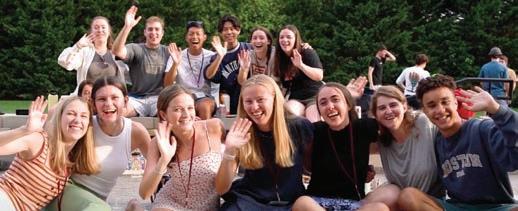





14 4 10 26 20 2 The Church in the 21st Century Center Highlights 4 Measuring Parish Vitality Daniel Cellucci 6 Dear Future Church Dennis J. Wieboldt III 8 Share Your Faith Stories Thomas Groome 10 Young People: Temples of the Holy Spirit Casey Beaumier, S.J. 12 Catholic Schools: A Way Forward Melodie Wyttenbach 14 The Treasure of Hispanic Catholicism Hosffman Ospino 16 The Church and Contemporary Challenges Richard Lennan 18 Living Catholicism: A Church in Need of Its People Fr. Michael J. Himes 20 Lighting the Way Joan D. Chittister, OSB 22 Priestly Ministry and the People of God Thomas Groome 24 The Synod: A Transformative Process Sr. Nathalie Becquart, XMJC 25 Women in Ministry: Voices 26 The Joy of Love Gerard O’Connell 28 Thou Shalt: Sex Beyond the List of Don’ts Lisa Fullam 30 Witness to Love Mary-Rose Verret 32 A Wondrous Adventure: The Catholic Intellectual Tradition Fr. Robert P. Imbelli 34 Critical Challenges for Catholic Higher Education Gregory A. Kalscheur, S.J. 36 Finding God in the Catholic Imagination Paul Mariani 38 The Gift of Education and the Intellect Fr. Michael J. Himes 39 Best Practices in Digital Ministry John T. Grosso 32
2002
ϐ Boston College President William P. Leahy, S.J., announced The Church in the 21st Century (C21) Initiative as a two-year effort to examine issues raised as a result of the sexual abuse scandal in the Catholic Church and to provide intellectual and religious resources to serve as a catalyst for renewal. BC was the first Catholic academic institution in the country to begin such a project in response to the crisis.
ϐ A Steering Committee was appointed to chart the direction of the C21 Initiative; a larger Advisory Committee—composed of faculty, staff, alumni, and students—was also appointed to be broadly representative of all segments of the University. The committees were led by Fr. Leahy and its co-directors—the late Robert R. Newton, special assistant to the president, and Mary Ann Hinsdale, associate professor of theology.
ϐ The C21 Initiative launched its first event, a forum at Robsham Theater titled "From Crisis to Renewal: The Task Ahead" (September 18). Twenty years later, over 1,000 events have been sponsored by the C21 Center, both on-campus and online, drawing on the wisdom of BC faculty, students, and renowned experts nationally in the fields of theology, philosophy, history, science, English, business, and the arts.
2003

ϐ Three main foci were identified to guide C21 programs, events, workshops, and publications: Handing on the Faith, Roles and Relationships in the Church and Sexuality in the Catholic Tradition. A fourth, the Catholic Intellectual Tradition, was added in 2005.
ϐ The C21 Center first published C21 Resources, a compilation of the best analyses and essays on the Church's key challenges. To date, 35 issues of the magazine—containing over 600 articles—have been published,
the church in the 21 st century


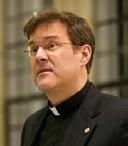
mailed twice a year to a circulation of 180,000 households. This hallmark publication is a resource employed by individuals, schools, parishes, religious educators, and faith formation programs. An inclusive archive of past issues is available on the C21 Center website. Additional print copies of the publication are distributed by request and free of charge.
ϐ The Boston College Alumni Association hosted Road to Renewal, a series of events hosted nationwide at which Fr. Leahy met with alumni and discussed the Catholic Church and the C21 Initiative.

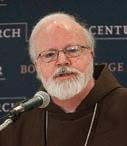

ϐ The C21 Center established the Episcopal Visitors Program, which engages members of the Catholic hierarchy in conversation about important issues in the Church. Each year, bishops and cardinals are invited to campus to experience life at a Jesuit, Catholic university and to meet with students, faculty, and administrators.
2004


ϐ After hosting over 100 public events, the University announced the C21 Initiative would become The Church in the 21st Century Center, a permanent resource in service to the Catholic Church.
ϐ C21 Online was established to provide adult Catholics with opportunities to grow in faith through online courses and programs. This grant-funded partnership with the Institute for Religious Education and Pastoral Ministry at BC eventually became part of the School of Theology and Ministry in 2008. It is now called STM Online: Crossroads, serving over 1,100 learners annually.
ϐ The C21 Series on Women highlighted the concerns and ideas of women in the Catholic Church. The C21 Center hosted two conferences—“Envisioning the Church Women Want” (spring 2004) and “Creating the Church Women Want” (summer 2006)—which inspired future publications.

2005
ϐ The C21 Center launched the C21 Book Series, compiling content from its conferences, symposia, and publications into a series of books. Fifteen books define the collection, the first of which being Church Ethics and Its Organizational Context
2006
ϐ The first rendition of Agape Latte, BC’s popular faith storytelling series for students, took place. Since its inception, BC has hosted over 130 Agape Latte events on campus.
2008
ϐ The C21 Center expanded its Student Advisory Board, empowering BC students to be stakeholders in the work of the Center in service to the Church. Student Board members help plan on-campus events—including Agape Latte—and meet with members of the faculty, administration, and Church hierarchy. By 2018, the Board grew to over 85 students.
ϐ The C21 Center launched its YouTube Channel. The extensive video and audio archive of events and lectures has attracted over 1.1 million views, with visitors from more than 98 countries.
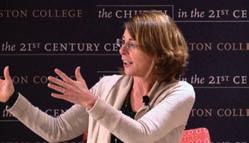
2009
ϐ The grant-funded initiative “Touchstone for Preaching” was created to help priests and deacons hone their preaching skills. As part of its “Encountering the Gospel: Renewing the Preacher” series, the C21 Center hosted two dozen workshops over a two-year period.
2012

ϐ The Center published two books— Encountering Jesus in the Scriptures and Catholic Spiritual Practices—combining articles and reflections from past issues of C21 Resources magazine with new, expanded content.
ϐ In partnership with the Office of Campus Ministry, the C21 Center
2 c21 resources | winter 2022/2023
century center highlights

established Espresso Your Faith Week, an annual week of over 30 oncampus student events that celebrate Ignatian spirituality and the gift of God working in our lives.
2015
ϐ The C21 Center received an anonymous grant to franchise the Agape Latte program at other colleges and universities nationwide— not just at Catholic, Jesuit institutions, but also at public and secular, private institutions. Eventually, high schools and parishes also adopted the program. Over 120 franchises have launched to date, influencing the faith lives of tens of thousands of students.
2016
ϐ The C21 Center produced the first episode of GodPods, a podcast conversation series discussing key challenges and opportunities facing the Church. Listen to GodPods for free on Spotify, Apple Podcasts, Stitcher, or wherever you get your podcasts.
ϐ In partnership with the Institute for Advanced Jesuit Studies, the C21 Center developed Ever to Excel, a week-long, on-campus summer program for high school students to experience Boston College through the lens of Ignatian spirituality. Undergraduate BC students serve as mentors to the participants throughout the week. To date, 750 high school students from across the country and around the world have participated in the program.
ϐ A two-year faculty seminar, “A Theology of Priesthood for Our Time,” was established to provide the Church with a contemporary theology of priesthood that can guide its recruitment and preparation of candidates and help to address pressing pastoral issues surrounding priesthood in our time. The fruits of this seminar were later published in a compendium, To Serve the People of God: Renewing the Conversation on Priesthood and Ministry
2018
ϐ In the wake of the Pennsylvania grand jury report on clergy sexual abuse, hundreds attended the C21 Center’s forum “Why I Remain a Catholic: Belief in a Time of Turmoil” in Robsham Theater.

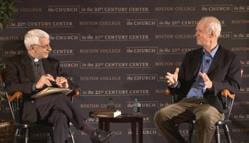

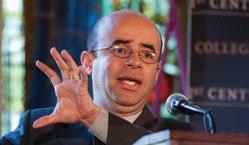
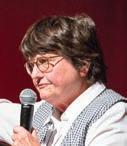
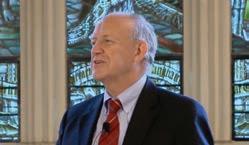


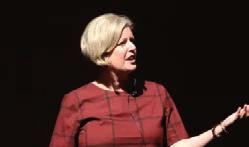
2019
ϐ Hundreds attended the C21 Center’s four-part Easter speaker series “Revitalizing Our Church.” Panelists from diverse areas of expertise offered their ideas on how the Church can be a more effective institution, restore its credibility with the faithful, and move forward with the hope of Easter.
ϐ Faith Feeds, a conversation-based faith sharing program for individuals, parishes, and Catholic schools, was launched by the C21 Center. To date, over 200,000 free Faith Feeds facilitation guides have been downloaded from the C21 Center website. A Zoom model of Faith Feeds was offered during the pandemic, providing an opportunity to gather weekly with people from around the world. The online program continues each Friday at 1 p.m. EST.
ϐ In partnership with Paraclete Press, the C21 Center launched the children’s book Drawing God, encouraging children to creatively express how they see God. Authored by the C21 Center’s director, Karen Kiefer, the book inspired the annual World Drawing God Day, an online Drawing God Museum, and curriculum-based projects for parents, parishes, and Catholic schools.
2020
ϐ During the pandemic, the C21 Center, in partnership with the Roche Center for Catholic Education, launched Breakfast with God, an online Sunday morning children’s faith formation show. Hosted by a Jesuit priest and a Catholic preschool teacher, over 80 episodes were livestreamed on Zoom to a community of over 1,000 families. Breakfast
with God downloadable guides are available on the C21 website for parents, religious educators, and Catholic school teachers interested in replicating the program.
ϐ Between 2020 and 2022, as part of the first phase of the Student Voices Project, the C21 Center surveyed 1,500 high school and college students from across the country, asking what their hopes are for the Catholic Church. The Center compiled this data and submitted a report to the Vatican as part of the Synod on Synodality. Now, as part of the second phase of the Project, the Center is actively sharing the free diagnostic tool used in the study with Catholic educators nationwide to help them gauge their students’ faith development.
2021
ϐ More than 200 virtual events were hosted by the C21 Center, nourishing Catholics of all ages during the pandemic.


2022
ϐ The C21 Center, in partnership with the BC Alumni Association, launched Pray It Forward, an opportunity to pray together weekly as a BC community for 15 minutes on Zoom, Wednesdays at 4 p.m. There are currently 700 members in the online community from across the country.
ϐ Lunchtime virtual retreats were offered for the first time by the C21 Center; one during Lent and one during Ordinary Time. Hundreds of people participated, many new to the C21 community.
ϐ The Center developed Mass and Mingle, a new social opportunity for 20- and 30-something Catholics that will be piloted in the Greater Boston area. Once a month, young adults are invited to attend a 5 p.m. Sunday Mass, followed by a one-hour social infused with Ignatian spirituality.
photo credits: Visit this issue's theme page: bc.edu/c21anniversary20
Celebrating 20 Years | ANNIVERSARY ISSUE 3
Parish Vitality
Daniel Cellucci
W
what makes a great parish ? For many Catholics, the answer lies in a series of anecdotal, nostalgic, or sometimes consumeristic statements that speak to what a parishioner might receive or experience. Oftentimes these descriptions are incomplete and can include defensive rationalizations that seek to explain the current state versus what could or should be. Given the breadth of the Church’s reach and history, the “official” definition of a parish, and the standards of what constitute a fruitful one, are likewise broad and abstract. In a relatively stable landscape where resources are abundant, a broad and vague understanding of parish vitality does not present an issue. Unfortunately, the landscape of the last three decades has been anything but stable, which has significant implications on how we understand and support parishes both now and in the future.
Beginning in earnest in the early 1990s, U.S. dioceses, mostly in the Northeast and Midwest, have faced the increasing challenge of adapting a parish footprint that was built for a different time. Along the southern half of the country, immigration and migration has created a different set of challenges and opportunities related to the parish experience. How does a diocese determine where to allocate increasingly scarce financial and human resources? Is a parish’s standing determined by demographics alone? Which parishes “deserve” the best leaders, whether they be clergy or lay professionals? And even in the contexts where financial resources should be available and the larger population is growing, what determines why one parish may thrive and one may barely survive? These are not simply rhetorical questions. They increasingly represent a heartbreaking reality for every level of Church leadership, especially for the people in the pews who often feel surprised and robbed when their parish experiences any forced change, from the need to share a pastor to a potential merger or even closure.

In the last decade, a plethora of apostolates, programs, and resources have emerged to try to equip


parish leaders to achieve increased vibrancy. While these efforts provide helpful strategies and encouragement to attend to various aspects of parish life, often one of the most difficult challenges in parish transformation is convincing parish leaders and parishioners that there are objective standards against which parishes should be evaluated. A lack of understanding of the global mission of the Church, as well as a lack of objective understanding of one’s own parish situation, not to mention the parishes nearby, further exacerbates this barrier to evaluation and the inability to identify what opportunities exist within a given community.
In 2014, Catholic Leadership Institute (CLI) introduced the Disciple Maker Index, a parish survey tool t hat invites parishioners to reflect on where they are in their individual discipleship and their relationship with their parish. As of 2022, the survey has reached over 500,000 Catholics from more than 2,100 parishes in over 50 dioceses, responding in 22 different languages. Because of the nature of survey collection methodology, the respondents skew heavily toward Mass-going Catholics. Since its inception, the survey findings point to one statistically significant determinant when it comes to parishioners’ perceptions of vibrancy: leadership. Across all ministry contexts, parishioners are eleven times more likely to indicate their willingness to recommend their parish to a friend and four times more likely to indicate the parish is helping them grow spiritually if they are likely to recommend their pastor. Other key drivers, such as hospitality, the Sunday worship experience (inclusive of preaching), and the parish’s ability to communicate effectively, are important but are dwarfed in comparison to the perceived effectiveness of leadership.
4 c21 resources | winter 2022/2023
HANDING ON THE FAITH MEASURING
These findings, while clear, create an additional challenge for Church leaders. If the secret to parish vibrancy is having a great leader, where does that leave a U.S. Church that faces an aging and increasingly scarce presbyterate? What implications does that have for lay leadership in parishes? In what areas of parish life does co-responsibility become most important? How, and in what areas, should future priests, deacons, religious, and lay leadership be formed and trained? Without a shared vision for what constitutes parish vitality, this continues to feel like throwing darts in the dark.

Establishing a framework of clear and objective metrics can validate or challenge deeply held beliefs about some of the entrenched narratives that are part of our lived experience. Metrics can help to show what we believe does and does not work. Clarifying and prioritizing the most relevant metrics of parish vitality is not at odds with our call to be relational or with the human experience, nor do metrics limit or seek to replace the work of the Holy Spirit in our parishes. They do, however, create a heightened sense of accountability, which i s essential to any missional organization. If we can come to a shared understanding of what can and should be measured in terms of parish vitality, then we can do a better job of discerning how the Spirit is animating us in our proclamation of the Gospel.
CLI gathered existing frameworks from dioceses that have been used to guide conversation, self-study, and planning for parishes. While many frameworks shared similar categories for the primary functions of a parish, they often also shared a lack of concrete metrics or standards within those categories that would provide a helpful benchmark on vitality. Often, the frameworks relied on the subjective assessment of a body like the pastoral council to assess an area like welcome or outreach.
However, it was encouraging to see the degree of overlap and agreement that existed across dioceses and among parish leaders about what was considered foundational. This led us to ask the question, “If there is


general agreement about what a parish needs to do, what is missing?” As we looked to the examples of parishes displaying vitality in a multitude of contexts, it was not primarily the presence or absence of a foundational ministry that determined vitality but rather the presence or absence of certain behaviors or attributes that defined how these parishes fulfilled those ministries. For example, there was little disagreement that one of a parish’s primary functions is the celebration of the Eucharist. However, a greater determinant of vitality is not simply whether or not the parish celebrates the Eucharist but how the community engages in that worship. Is the worship intentional? Do the lay faithful fully and actively contribute to their responsibility? How well does the parish equip and form those called to lead worship? The old adage that “culture eats strategy for breakfast” seems to apply in the framework regarding which metrics are most relevant for looking at parish vitality.
Synodality creates a great opportunity to continue dialogue on this important question: The question about what makes a parish great is not one that a single bishop or pastor can answer. It requires a deep and consistent listening to the Holy Spirit speaking through the People of God. If parish is not just what we do but who we are, we must continue to dialogue about who we are to each other, who we are together, and who we are together in Christ to the rest of the world. Our continued communal discernment about how we journey together will in and of itself be an expression of our vitality. ■

Daniel Cellucci is CEO of Catholic Leadership Institute, an apostolate providing leadership training and consulting to more than 290 bishops, 2,700 priests, and over 33,000 deacons, religious, and lay leaders in more than 100 dioceses.
This article is adapted from a whitepaper produced by CLI. For more information, contact CLI at: info@ catholicleaders.org.
Read C21 Resources

Catholic Parishes: Grace at Work (Spring/Summer 2020).



Guest Editors: Michael R. Simone, S.J., and Joseph E. Weiss, S.J.

Celebrating 20 Years | ANNIVERSARY ISSUE 5
this issue's theme page: bc.edu/c21anniversary20
photo credits: Visit
SPRING/SUMMER 2020 CATHOLIC PARISHES
AT WORK
If parish is not just what we do but who we are, we must continue to dialogue about who we are to each other… and who we are together in Christ to the rest of the world.
GRACE
Dear FUTURE Church…
Dennis J. Wieboldt III
A
as a candidate for Confirmation at St. Matthias School in Somerset, NJ, I distinctly remember participating in a program known as “Service WorX.” All Confirmation candidates were required to participate in this program, presumably in the hopes of demonstrating the program’s motto: “Faith without works is dead.” Written in bold letters on the back of our program T-shirts, this motto embodied a central tenet of the Catholic faith—to do good works in the world is to be faithful to the Catholic tradition.
Since Pope Leo XIII’s publication of Rerum Novarum in 1891, Catholics have become increasingly cognizant of the Church’s social teaching. Today, most Catholics are likely to recognize the importance of the preferential option for the poor, the protection of human dignity, the respect for the gift of life, and other dimensions of the Church’s social witness. In the United States, attention to Catholic social teaching has become particularly widespread in recent years, especially among students at Catholic colleges and universities. At Boston College, for instance, students can often find innovative courses that apply Catholic social teaching to pertinent issues of economic injustice, racial discrimination, environmental degradation, and more.
Catholics must witness to a faith that does justice in the world. My hope for the future Church, however, is that we also not forget other dimensions of the faith that are equally important. As the American Church in particular continues to minister to the poor, immigrants, women in crisis pregnancies, and others on the margin, I hope that we will also embrace the sacraments, the
richness of the Catholic intellectual tradition, and the Church’s focus on community.

Fortunately, the Church need not choose one path over the other. We need not choose an exclusive emphasis on social issues over an appreciation of the sacraments, nor an exclusive emphasis on the sacraments over the pursuit of social justice. Rather, we must remember what makes the Church the Church, in all of its depth and complexity.
Focusing the Church’s pastoral attention somewhere between these two extremes is not just a personal preference but based on real experience and concrete evidence.
I n 2020, the C21 Center launched the Student Voices Project to better understand how Boston College students understand their faith. Between November 2020 and October 2021, the Project engaged with nearly 550 students through small focus groups and online surveys. In this initial phase of the Project, Boston College students expressed hope that the Church would help them develop a greater understanding of how the Catholic spiritual and intellectual traditions can make sense of their lived experiences.
For example, a majority of respondents expressed their appreciation for Boston College’s distinctive academic programs because they integrate the Church’s spiritual and intellectual traditions with contemporary issues. In many cases, students noted particularly positive experiences with Boston College’s Complex Problems and Enduring Questions courses—multidisciplinary courses taught by faculty in two academic d isciplines that integrate, for instance, faith and reason,
6 c21 resources | winter 2022/2023 HANDING ON THE FAITH
evolutionary biology and biblical narratives, or Catholic theology and neuroscience.
Beyond the Church’s intellectual tradition, the Student Voices Project demonstrated that students desire a sense of community on campus around their faith. Whether involving community-based events after Mass or intentional service programs, respondents repeatedly emphasized the importance of the Church’s understanding of community. Importantly, this emphasis on community was held alongside equally emphatic support for promoting a faith that does justice.
When Pope Francis announced the Synod on Synodality—a major part of his broader plan to create a “listening Church”—the C21 Center placed the Student Voices Project in service of the Synod. With the goal of listening to the experiences of high school and college-aged students from around the United States, the national phase of the Project engaged an additional 1,000 students through online surveys. Hailing from 26 schools in 14 states, over 95% of the respondents to the Project’s national phase were of high school age. This offered the C21 Center a unique opportunity to identify common themes in the hopes of high school and college-aged students.
Not unlike their college-aged peers, high school students expressed a desire for greater understanding of their faith and a sense of meaning in practicing it. Similarly, high school respondents to the Project’s national survey articulated their hope for greater community around their faith, in addition to more direct engagement from Church leaders around pressing social issues.
In both iterations of the Project, students expressed hope that the Church would accompany them in a pastorally responsive way, one that helps them understand what the Church teaches, why the Church believes it, and why (and how) it should matter in their lives. Put more simply, students wanted to talk about difficult issues, not merely be talked to about them.
Placed amidst the backdrop of their emphasis on inclusion and belonging, students who participated in both phases of the Project demonstrated interest in an intellectually and spiritually robust faith that does justice in the world.
As the Synod on Synodality continues, it is critical that we think more intently about the experiences of young people in the Church, not least so that the Church can understand how to accompany the next generation on its faith journey. Though many headlines about young people in the Church are focused on social issues alone, conversations with students at Catholic high schools, colleges, and universities through programs like
the Student Voices Project reveal that the Church must balance the distinctive social, intellectual, and spiritual features of the Catholic faith.
Doing so means witnessing to a faith that does justice, but it also means embracing the sacraments, prayer, the Church’s rich intellectual tradition, and the Church’s unique emphasis on community.
I have great hope for the Church’s future, but our success in witnessing to the full message of the Gospel will be tethered to whether Catholic institutions and “we” the Church remember not to overemphasize some aspects of the Catholic tradition at the expense of others.
Embracing Christ’s exhortation to “make disciples of all nations,” then, requires us to witness to what makes the Church the Church. ■
Dennis J. Wieboldt III is an M.A. candidate in history at Boston College and the co-director of the Student Voices Project. A 2022 graduate of Boston College, he has been a member of the Church in the 21st Century Center’s Advisory Committee for three years.
The Church in the 21st Century Center recently concluded its two-year-long study, the Student Voices Project, of how Catholic high school and college students understand their Catholic faith. Now, as Catholic educators explore new ways to reinforce their mission and Catholic identity, the Center is ready to share its free diagnostic tool, used in the study, to help them learn more about how their students understand their faith.
Are you interested?
Please contact the C21 Center to begin the conversation: church21@bc.edu

To learn more about the Student Voices Project, and read the executive summary and full report that were submitted to the Synod on Synodality, visit: bc.edu/futurechurch.

Celebrating 20 Years | ANNIVERSARY ISSUE 7
“Students expressed hope that the Church would accompany them in a pastorally responsive way, one that helps them understand what the Church teaches, why the Church believes it, and why (and how) it should matter in their lives.”
photo credit : Courtesy of Yiting Chen, Boston College
Share Your Faith Stories

“ so are you excited about your First Holy Communion next Sunday?” asked Nana Peg of her granddaughter Cara. And little Cara went on excitedly about the rehearsal she and her second-grade friends had been through, her cool new outfit, and the great party afterwards in her backyard, adding, “You’re coming, Nana, right?” Peg assured Cara that she wouldn’t miss it for the world and said, “Oh, you’ll have lovely memories, Cara, of your First Communion day; you’ll remember it all your life, as I do.”
Then Nana Peg, beginning with “I remember so well…,” told a great story of her own grand day, and Cara was rapt with attention. Peg reminisced with obvious joy and wound down with, “When I finally received Holy Communion, the first thing I said was ‘Welcome Jesus and thanks for coming to me today.’” “Ah,” said Cara, “that’s what I’ll say to him, too, Nana.”
As I reflect now on my eavesdropping to that lovely round of stories, I’m reminded again of what gifts we all have to share from our personal stories of faith. Indeed, there is probably no more effective way for us to share “the greatest Story ever told”—Christian faith—than through the filter of our personal stories. This is heightened all the more when parents and grandparents share such stories with their children and grandchildren (and surely aunts and uncles, too). Nothing is more effective in evangelizing than the storied witness of Christian faith.
Of course, we will always need effective formal catechesis in our parishes and schools. This is necessary to ensure that we “hand on” (the literal meaning of the Greek katekesis) the whole Christian Story and likewise the great Vision it proposes for living Christian faith— faith that is alive, lived, and life-giving for ourselves and for “the life of the world” (John 6:51). For sure, there is nothing more persuasive than to access that great Story through the personal faith stories we can all share with the rising generations.
If a key strategy for passing on the faith is through our own faith stories, this begs the question of how best to craft such conversation. As Aquinas wisely advised, sharing our faith should ever be done “according to the mode of the receiver.” The heart-engaging power of stories suggests that we can craft our own faith narratives to intentionally lend access to the great Story and Vision of Christian faith.
To return to my eavesdropping, I note well how Nana Peg drew out Cara’s story first before she shared her own. And I propose that there is no better example of such story-to-Story pedagogy than that of Jesus himself. There are innumerable examples of him drawing out people’s stories in the midst of sharing his own great Story—the Gospel of God’s reign. Recall how he crafted his conversation with Nicodemus (John 3), or with the Samaritan Woman (John 4), or with the disciples on the Road to Caesarea Philippi (Matthew 16).
Indeed, it seems as if Jesus almost always began his teaching with some familiar narrative from his listeners’ daily lives. So, the reign of God is like fishermen sorting fish; I bet he was talking to people sorting fish or at least with those familiar with this morning work. Or the reign of God is like a woman baking bread; I imagine him talking to the women at the well. Or note when he was talking to farmers about sowing seeds, and the examples go on. Then, in the midst of such familiar stories from his listeners’ lives, Jesus taught them “with authority” (Mk 1:22) the Story of faith and invited their lived response for God’s reign (Mk 1:15)—God’s Vision for us all. Pedagogically, Jesus was engaging his listeners’ own stories as an entreé into the great Story he had to share.
Though this “story-to-Story” pedagogy is present throughout Jesus’ public ministry, nowhere is it more evident than with the two disciples on the Road to Emmaus (check Luke 24:13-35). Recall how they are leaving
8 c21 resources | winter 2022/2023 HANDING ON THE FAITH
S
photo credit : Courtesy of Lee Pellegrini, Boston College
Thomas Groome
Jerusalem (running away?) for Emmaus—a seven-mile journey. Jesus, now the Risen Christ, approaches, joins their company, and “walks along with them.” For some reason (blinded by their broken hearts at the death of their beloved Jesus?) they don’t recognize him.
Even more amazing, however, is that Jesus doesn’t begin by telling them what to see. Instead, as he walks with them (Pope Francis cites this text as a model of catechetical “accompaniment”), Jesus first draws out their own tragic story of how he was taken and crucified, and now their shattered hopes for a Messiah “to set Israel free” (from Roman rule?).
Only when he has drawn out their own painful story and lost hope does he catechize his version of the great Story of the faith community. So, “beginning with Moses and all the prophets he interpreted for them every passage of Scripture that referred to himself,” and explained how the Messiah had to suffer “so as to enter into his glory.”
Now their own stories and the faith Story are on the table, yet the Stranger still doesn’t tell them what to see but waits for them to put the two together and come to see for themselves. Which they do, after they have offered him hospitality, and he sits with them at the table for “the breaking of the bread.” In that eucharistic moment, they recognize the Risen Christ, whereupon he vanishes from their sight. In many ways, his work was done—they had come to “see” for themselves and thus renewed their own faith. He likely was off to another Emmaus road—as to the dinner table in your family.
Now the two disciples recall how their “hearts were burning as he opened the Scriptures for us.” Would that we can do likewise—to craft the great Story to burn into people’s hearts. Surely the clue to setting hearts afire is that we connect and integrate people’s own stories with the great Story of Christian faith.
I warrant that at least once a day every child asks a question or raises an issue or makes a protest or takes a stand that demands the attention of their caregivers. When this happens, take the time to draw out their “story”—the narrative of what is going on with them or happening to them. Not always but often, we can find an entrée in such moments to share a faith perspective, to sow a seed from our own faith story to reflect the great Story of Christian faith.
In our daily lives there are constant opportunities to share an explicit faith story, as with Nana Peg and Cara; be sure to take them—they are golden for handing on the faith. And there will be implicit faith moments as well, when you are simply encouraging their faith in themselves, in others, in life. Take those opportunities, too.
So, like Nana Peg and that Stranger on the Road to Emmaus, ever try to draw out your child’s own stories first. That will likely lend a clue for how best to craft your personal faith stories as an entrée into the great Story and Vision of Christian faith. We have no greater gift to share! ■
Thomas Groome is a longserving professor of theology and religious education at Boston College’s School of Theology and Ministry, and director of BC’s Ph.D. in Theology and Education. He is a former director of the Church in the 21st Century Center.
This revised edition of “Share Your Faith Stories” was originally published in C21 Resources—Our Faith Our Stories (Fall 2015). Guest Editor: Brian Braman.
Learn more about the C21 Center's popular Agape Latte program, a monthly faith storytelling series for teens and young adults. It was founded at Boston College in 2006 and has spread to over a hundred high schools, colleges, and parishes nationwide.


Interested in bringing Agape Latte to your school or parish?


Contact the C21 Center at church21@bc.edu

Celebrating 20 Years | ANNIVERSARY ISSUE 9
A Catalyst and Resource for the Renewal of the Catholic Church Our Faith Our Stories
“There is probably no more effective way for us to share “the greatest Story ever told”—Christian faith— than through the filter of our personal stories.”
Young People: Temples of the Holy Spirit
 Casey Beaumier, S.J.
Casey Beaumier, S.J.
Yyoung people crave spiritual conversation and, if given the opportunity, experiences to explore and to express the inner movements of their hearts within the community of their peers. Beginning in 2016, Boston College has been home to a program that introduces high school students to such an opportunity. These students are engaging the Spiritual Exercises of Saint Ignatius of Loyola through Ever to Excel, a program that has now hosted nearly 800 students from all over the world. These students arrive on Sunday in time for an opening dinner and remain on campus until Friday after lunch. During the course of the week and under the guidance of Boston College undergraduates who serve as mentors, the students experience important movements of the Exercises through video presentations, k eynote speakers, faith-sharing groups, and nightly candlelight Masses. The goal is to make accessible those stirrings of the interior life that are worthy of attention and strengthening. Young people understand the value of physical exercise and the role it plays in contributing to living a good and balanced life. It is through this association that Ever to Excel presents spiritual exercise as a means for living out a faith life, which like physical exercise, contributes to living a good life.
Each day brings to the participants different exercises that afford them with opportunities to stretch t hemselves interiorly with the hopeful outcome of stronger character and faith. While not all of the students are Catholic or even Christian, the program is explicit in its Catholic spirituality in a way that makes the content appealing and engaging for everyone. For example, on the first day of the program,
students explore the First Principle and Foundation of the Exercises, and they spend time pondering and discussing their identity before God as beloved sons and daughters, companions of Christ, and temples of the Holy Spirit. In other words, each person’s identity before God reveals worthiness of unconditional love, friendship, and respect. This identity is the great equalizer within the human family and this starting point e nables participants to begin to engage one another with eagerness and anticipation. The remaining days build upon this foundational beginning and include themes such as formation, discernment, pilgrimage, mission, and magis.
The undergraduate mentors are prepared with faith-sharing questions for each day. These key questions become the focus of the small-group activities that t he mentors facilitate. The outcome of these exchanges is increased capacity to listen with interior ears and to speak with greater vulnerability and sincerity. This style of spiritual conversation is foreign to most young people today and can even seem to be off-putting at the beginning. By Friday, however, it has not been unusual for students to say that Ever to Excel was the most important week of their lives. They have experienced a level of engagement that they have been craving and that the Lord has wanted them to experience in order to grow closer to Him. ■
10 c21 resources | winter 2022/2023
HANDING ON THE FAITH
Casey Beaumier, S.J., is the University Secretary at Boston College and the director of the Institute for Advanced Jesuit Studies.
photo credits: Institute for Advanced Jesuit Studies—A. Taiga Guterres
Each summer, Boston College students serve as mentors to the high school participants in the Ever to Excel program.
High school students from around the world are invited to Boston College this summer for the Ever to Excel program. Drawing from the wisdom of the Spiritual Exercises of St. Ignatius of Loyola, the program provides rising sophomores, juniors, and seniors the resources and supportive community environment to contemplate how to create a more meaningful life through the lens of Jesuit spirituality.


Session I:
Sunday, July 23, to Friday, July 28, 2023

Session II:
Sunday, July 30, to Friday, August 4, 2023
For more information about Ever to Excel and the application process, please visit bc.edu/ evertoexcel or email evertoexcel@bc.edu

Learn more:

Celebrating 20 Years | ANNIVERSARY ISSUE 11
“Each person’s identity before God reveals worthiness of unconditional love, friendship, and respect.”
Melodie Wyttenbach
C Catholic Schools A Way FORWARD
catholic schools are true treasures in the life of the Church. Across the globe, nearly 35 million children attend Catholic primary schools, 20 million attend Catholic secondary schools, and more than 7 million attend Catholic preschools and nurseries. Serving 1.6 million students in the United States alone, Catholic schools have a history of being centers of evangelization, and of social and intellectual empowerment, for millions of Catholics and others.
With the conviction that human beings have a transcendent destiny, U.S. Catholic schools have been a beacon of light in times of uncertainty. In the late 1800s, with faith as an anchor, thousands of European immigrants turned to Catholic schools to educate their children as they transitioned their families to a new country. Immigrant families found comfort in community, and a space where their language, culture, and traditions would be honored. More recently, between 2020 and 2022, a time marred by an uncertain COVID19 pandemic, Catholic schools with a resilient spirit and agile leaders found a way to re-open safely despite the unknowns of a microscopic virus. “In fall 2020, while just 43% of public schools and 34% of charter schools offered in-person learning in September, 92% of Catholic schools offered in-person learning.” As the doors opened, and Catholic schools prioritized in-person learning, a boost in enrollment resulted, the first in decades.

“The light shines in the darkness and the darkness has not overcome it.” (John 1:5)
In both situations, the light of Catholic schools became evident as Catholic education “involves not just the head but the heart, not just the soul but the body. Physical exercises are as important as spiritual exercises. Learning is as important as a good diet. Students pray,
learn, and eat healthily as ways to glorify God and care for their entire selves. All are gifts from God.” This holistic approach to education is what sets Catholic education apart and it occurs because Catholic educators center cura personalis and accompaniment.
Cura personalis is Latin for “care of the whole person” or “care for the individual person.” Cura personalis envisions and cares for the person as God envisions and cares for her or him. Cura personalis reminds all educators that education does not end with academic excellence, but helps the person grow in his or her relationship with God.
Pope Francis sees accompaniment from numerous practical and theological angles, where essentially we a re not alone, and we experience the divine through community. Catholic schools embrace accompaniment as a central tenet as to how we educate: “… we need a Church capable of walking at people’s side, of doing more than simply listening to them; a Church which accompanies them on their journey; a Church able to make sense of the ‘night.’”
We live in a rapidly changing and increasingly global society. At times it feels as if the “night” is all around us—in the darkness of living in the midst of a pandemic, during an age of polarized politics, climate change, mass shootings, and escalating mental health issues. Now more so than ever do we need schools that
12 c21 resources | winter 2022/2023
HANDING ON THE FAITH
Catholic schools will continue to inspire children to change society and the world for the better.
embrace cura personalis and are willing to accompany their students and families in a holistic manner. It is because of this need that Catholic schools meet that they will continue to inspire children to change society and the world for the better.

Catholic schools are and will continue to be a central mission of the Church in this century and the next. As readers of this 20th anniversary issue look to breathe new life into the Church, we must begin with our youth, as they hold the greatest hope for our future. As people of faith, we must continue to support our Catholic schools—giving one’s time, treasure, and talents—in ways that let the light of these schools shine even brighter. This may mean when there is a need for substitute teachers, consider the time you may be able to give. When there is a capital campaign for facility upgrades, consider the resources you may be able to give. When you see students preparing for their First Communion, consider the prayers you may be able to offer. We all can play a part in amplifying the light of Catholic schools. And the future of our Church starts with our youth. Now is the time to let their light shine. ■
Melodie Wyttenbach is executive director of the Roche Center for Catholic Education and a faculty member for the Lynch School of Education and Human Development at Boston College.
BREAKFAST WITH GOD
Breakfast with God is a flexible children's faith formation program that creatively wraps prayer, song, a children's story, and a craft in a Gospel message.

T he Breakfast with God guides offer easy, step-by-step instructions for planning a Breakfast with God lesson in your home, classroom, parish, or virtually on Zoom. Each downloadable guide focuses on a specific Gospel and theme.

For more information, please visit bc.edu/breakfastwithGod or scan this code.
FAITH FEEDS FOR CATHOLIC EDUCATORS


In partnership with the Roche Center for Catholic Education, the C21 Center developed FAITH FEEDS guides around gifts or virtues that challenge Catholic educators to reflect on how they are living out their vocation by being adaptable, joyful, attentive, visionary, and humble in their everyday lives.
Perfect for professional development!
For more information, please visit bc.edu/faithfeedscatholiceducators or scan this code.




Celebrating 20 Years | ANNIVERSARY ISSUE 13
Sources for this article can be found at: bc.edu/c21anniversary20 BREAKFAST WITH GOD GUIDE THEME: SHARING
photo credit : Jesus Ramirez
The Treasure of Hispanic Catholicism
 Hosffman Ospino
Hosffman Ospino
Aa breath of fresh air and renewed energy are profoundly transforming the entire U.S. Catholic experience from the ground up in many ways, thanks to the fast-growing Hispanic presence. Hispanics account for 71 percent of the growth of the Catholic population in the country since 1960. In large parts of the South and the West, as well as in a growing number of major urban centers throughout our geography, to speak of U.S. Catholicism is to speak largely of the Hispanic Catholic experience—and vice versa.
At the heart of the freshness and new energy that Hispanics add to the life of the Church in the United States are the people. Young people! The median age of U.S. Hispanics is 30. About 35 percent of all Hispanics in the country are under the age of 21. Ninety-four percent of Hispanics younger than 18 are U.S.-born. These are numbers that inspire hope. The potential of any society, or an institution like the Catholic Church, is intimately linked to its human capital, particularly the young. How U.S. Catholics respond to and engage Hispanic youth will likely be the most telling indicator to determine vitality and growth—or decline—of the American Catholic experience in the upcoming decades.
A GIFT FOR ALL
Much of the good news for the Church in the United States is that most Hispanics remain Catholic despite the increasing influence of secularism and pluralistic trends in our society. At a time when about a quarter of the U.S. population self-identifies as nonreligiously affiliated (or “nones”), Hispanic Catholics offer a rather countercultural alternative to such a dynamic by witnessing a faith that is rich in traditions, stories, rituals, expressions, and symbolism. Contemporary secularism, as philosopher Charles Taylor suggests, seems to be the consequence of a process of “disenchantment” of reality, a condition that prevents many people in our Western world to perceive and even encounter the sacred in the everyday. For millions of Hispanics, the worldview is much different, actually one that is more akin to the sacramental imagination that has given life to the Church for two millennia.
In many corners of our geography, it is not unusual to encounter Hispanic Catholicism displayed at its best through street processions during major holy days. The beauty of the murals and other artistic expressions that creatively
14 c21 resources | winter 2022/2023 HANDING ON THE FAITH
photo credit : National Shrine of Our Lady of La Leche —July 2020. Google.com
encapsulate the dialogue between Catholicism and Hispanic cultures is mesmerizing. Public displays of faith in neighborhoods and churches where Hispanics are present announce out loud that there is something novel in U.S. Catholicism: a unique opportunity to experience the richness of our faith tradition in new ways.
QUESTIONS AND TRANSITIONS
Mindful of the transformation that our faith communities are experiencing everywhere thanks to this Hispanic presence, Catholics of all racial and cultural backgrounds, including the millions of Hispanic Catholics who have been part of the United States of America for several generations, must contemplate two important questions. First, how do we allow ourselves and our communities to be sincerely transformed by the richness of the Hispanic religious and cultural traditions? Second, how do we best share with the present generation of U.S. Catholics, largely Hispanic, the many resources that helped the previous generations thrive? There is no doubt that we as a Church—and as a society—are becoming something new. And this is good news because renewal is always a sign of God’s Holy Spirit working in our midst.
Both questions point to the fact that this is a time of transitions that require a great deal of conversion: personal, communal, and pastoral. Transition for some Catholic communities and institutions means embracing Christian practices of hospitality and solidarity. For others it is about being creative to serve the pastoral and spiritual needs of Hispanics in ways beyond the usual. And still for others, transition requires a good measure of letting go, so the new voices can take as much initiative as necessary in the forging of the new American Catholic experience in the 21st century, fostering collaborative partnerships while drawing from the best of their own wells.
A GREAT OPPORTUNITY

It is often asked why there aren’t more Hispanic Catholics in positions of leadership in the Church and in the larger society, or why there aren’t more Hispanic Catholic families supporting our parishes and programs. Both are fair questions since Hispanic Catholics have lived in the U.S. longer than any other Catholic group. But the questions also demand that all Catholics in the United States look back at our history to examine attitudes toward Hispanics in our own communities and institutions. We also need carefully to assess how much we understand the complex realities that shape the lives of most Hispanics in the United States. This is the crux of the reflection that will likely define major choices and commitments within U.S. Catholicism during the first half of the 21st century.
It is interesting to observe, for instance, that more than two-thirds of Hispanics are U.S.-born, yet most outreach efforts on the part of the institutional Church focus on the immigrant portion. This is most evident in the context of parish life. Though a full quarter of Catholic parishes in the country have explicitly developed some form of Hispanic ministry, almost all define such ministry as pastoral outreach in Spanish and most
serve primarily Hispanic immigrants. One might read this as a major discrepancy that reveals the fast-evolving Hispanic Catholic experience and how slow we as a Church—including Hispanics of all generations—have adjusted to respond adequately to the reality of being American and Catholic in an increasingly Hispanic Church. There is an element of truth to this. But I prefer to read this reality more as an opportunity.
Since the middle of the 20th century, we have been writing a major chapter of the “Immigrant Church” experience, one that has been gradually reshaping U.S. Catholicism. Many Catholics have paid attention to this experience and done their best to engage it. Some have resisted the changes that come with this new chapter. Many others, too many I would say, have ignored it. Yet, numerous signs point to concerted efforts at this historical juncture to finally face the changing demographic and cultural trends directly impacting our faith communities and institutional structures. Paradoxically, we may be one generation, perhaps two, behind in our response. Yet, this is undoubtedly a great opportunity.
Catholics of all backgrounds are increasingly discerning how to seize the day engaging Hispanics who are U.S.-born. They are not immigrants nor fully assimilated into any of the most dominant embodiments of the larger U.S. Catholic experience. We seem to be at the dawn of something new, definitely a unique opportunity much anticipated by visionaries and thinkers who wrote about these matters half a century ago. Yes, it is an opportunity to imagine fresher approaches to youth ministry and catechesis in our faith communities, integrating the many rich expressions of Hispanic faith and cultures and responding to the questions of Hispanic youth in their own context. This is an opportunity to revisit how our Catholic educational institutions at all levels are living out their mission in service to the Church today, a largely Hispanic Church. This is the opportunity to actualize the Church’s prophetic commitments to life, justice, and truth, addressing the many challenges that prevent millions of young Hispanics—our Catholic children—from living fuller lives and from seeing the Church as a home on their spiritual journey.
What a great moment to be Catholic in the United States! ■
Hosffman Ospino is an associate professor of Hispanic ministry and religious education and chair of the Department of Religious Education and Pastoral Ministry at the Boston College School of Theology and Ministry.
An expanded version of this article was originally published in C21 Resources— The Treasure of Hispanic Catholicism (Spring 2016).
Guest Editor: Hosffman Ospino

Celebrating 20 Years | ANNIVERSARY ISSUE 15
Catalyst and Resource for the Renewal the Catholic Church SPRING 2016
The National Shrine of Our Lady of La Leche is located at the Nombre de Dios Mission in St. Augustine, Florida. Originally built in 1609, it is the oldest shrine in the United States.
The Treasure of Hispanic Catholicism
The Church and contemporary Challenges
Richard Lennan the church in the 21st Century Center at Boston College had its birth in the throes of the clerical sexual abuse scandal. The reverberations of that scandal continue even twenty years later, but today’s Church also confronts a raft of new challenges. This article surveys some of these and identifies possibilities for the Christian community to address them. The possibilities all have roots in the tradition of faith and provide ways for members of the Church to witness to the life-giving presence of the trinitarian God.
As the Church, our responsibility includes being alert and open to the movement of the Spirit. Doing so requires us to recognize and utilize the single largest resource we have to address issues in our world: our shared faith. It requires too that we never cease to ask whether all we do as Church reflects the Gospel.
1. Global anxiety resulting from COVID-19 and its attendant social and economic impact
Faith in Christ offers hope for the present, not simply for “the next world.” For the Church to embody this hope, all disciples of Christ must expand their vision beyond self-interest to an everdeepening openness to “the common good.” Membership of the Church, then, does not legitimate isolation from the needs of the world but summons us to compassion and generosity.
2. Burgeoning technology and the world of social media

Members of the Church can turn to Christ as “the way, the truth, and the life” (John 14:6). This anchoring offers a foundation that empowers resistance to “disinformation” and “misinformation.” Similarly, our grounding in the presence of God in humanity reminds us that “virtual” relationships cannot substitute for sharing each other's joys and sufferings.
3. A culture that combines— uneasily—a hunger for authenticity, suspicion of institutions, and escape into “celebrity”
Faith in the God who meets us in the humanity of Jesus affirms human life as the site of grace. Members of the Church can recognize unambiguously the limits of all human projects, but affirm—also unambiguously—that darkness cannot overcome grace. Nurtured through word and sacrament, members of the Church can live as people of hope, even in this complex moment.
4. A nti-racism, religious pluralism, and “decolonialization” Witness to the unconditional love of God for all people is an irreducible consequence of seeing human history as the venue for encountering the grace of God’s Holy Spirit. Members of the Church are called to resist anything that obscures the dignity of any person or group in society. The Church itself must remain open to conversion to God’s limitless vision for human thriving.
creation is also the God who creates and treasures all people. The Church’s care for the earth and option for the poor are never less than imperatives of Christian faith.
7. P revalence of “nones,” “disaffiliation” from the Church, decline in the social influence of the Churches, and the association between the Church and multiple forms of scandal
Today, “the Church,” especially our structures and ways of proceeding, is often an obstacle to the good news that the Church exists to proclaim. Rather than rail against “the times,” we, as Church, must be self-critical, while also discerning together possibilities for creatively faithful changes in our structures and forms of decision-making. Synodality, at the heart of which is truly listening to each other and to the Spirit, enhances these possibilities. ■
5. T he pluralism
of human experience in matters of gender and sexuality
In listening to, learning from, caring for, being in dialogue with, supporting, serving, and nurturing hope in all people, individual members of the Church, and the ecclesial communities to which they belong, can make Christ present. The Gospel summons us to presume goodwill in all people and to be attentive to the movement of the Spirit in every setting.
6. A nxiety for the future in light of “the cry of the earth and the cry of the poor”
Faith in Christ is inseparable from reverence for the physical world as not simply God’s creation but the venue for God’s incarnation in Jesus Christ. The God who gives life abundantly in
Richard Lennan is a priest of the diocese of Maitland-Newcastle, Australia, and is professor of systematic theology and chair of the ecclesiastical faculty at the School of Theology and Ministry at Boston College.
Read C21 Resources— The Vocations of Religious and the Ordained (Spring 2011).
G uest Editor: Richard Lennan
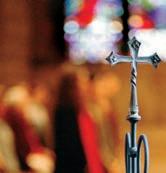
16 c21 resources | winter 2022/2023 HANDING ON THE FAITH
T
the vocations of religious and the ordained church in the 21 cent ury cen er
RESOURCES FOR HANDING ON THE FAITH

C21 Resources Magazine
Launched in the spring of 2003, C21 Resources magazine serves as the hallmark publication of the C21 Center. Each themed issue is a compilation of the best analyses and articles on key challenges facing the Church today. As with all C21 Center initiatives, it aims to serve as a catalyst and a resource for renewal, sparking conversation and reflection. Subscriptions and additional copies are complimentary to individuals, schools, and parishes.
Discover and download all 35 issues— or subscribe at: bc.edu/c21resources
The FAITH FEEDS program is designed for parishioners, teachers, and individuals who are hungry to share faith conversations over coffee or a potluck lunch/dinner with old and new friends. Pick a theme, download the guide, and gather in person or online.




Visit bc.edu/faithfeeds for more information on hosting your own FAITH FEEDS session or register to join the C21 Center’s weekly session Fridays at 1 p.m. (EST) by Zoom.



The C21 Center hosts Pray It Forward, a virtual, weekly prayer program on Wednesdays from 4:004:15 p.m. EST. Participants join by Zoom for a brief time-out to pray as a community. All are welcome!

(In partnership with the Boston College Alumni Association)
For more information and registration: bc.edu/prayitforward
Celebrating 20 Years | ANNIVERSARY ISSUE 17
Having a faith conversation with old and new friends is as easy as setting the table. FAITH FEEDS GUIDE OUR FAITH, OUR STORIES
THE CHURCH IN THE 21ST CENTURY CENTER SPRING/SUMMER 2022 FAITH IN ACTION Around the World C21 Resources Spring 22 FINAL_PRESS FINAL June8.indd 1
A Church in Need of Its People
Fr. Michael J. Himes
Ccatholicism is alive . Understanding this simple statement is crucial to understanding the nature of the Catholic Church. It is often easy to reduce Catholicism to a philosophy we subscribe to, or a list of truths we believe in. While philosophies and statements of truth are an integral part of being human, Catholicism is so much more. Catholicism is the ongoing history of the People of God. In other words, Catholicism is the life of what we have come to call “the Church.”
Catholicism is alive because we are alive as a community of believers. The way we live our lives is the life of Catholicism. St. Teresa of Avila put this sentiment into provocative and poetic words when she wrote:
“Christ has no body but yours. No hands, no feet on earth but yours. Yours are the eyes with which he looks. Compassion to the world.
Yours are the feet with which he walks to do good. Yours are the hands with which he blesses all the world.”
Take a moment to reflect on that fact. If we are honest with ourselves, this is a daunting realization. The relationships we have with others and the roles we fulfill in our communities are the life of Catholicism.
Articles like this are meant to be prompts for further reflection on the life of Catholicism as it is being lived out by the Catholic Church today. However, before discussing the different roles and relationships in the Catholic Church, such as the role of authority, or the relationship between our diocesan priests and their bishop, or how parishes might function, or any of the countless other issues that deserve discussion among Catholics today, the first question that we must answer is why we care about being a Church at all. Why do we need a Church with all its attendant problems and questions? Two reasons: because the Word has become flesh, and because God is love.
The too often unasked—and so, not surprisingly, unanswered—question about the Church is “Why have one?” This is not a question about the Church’s mission, important as such a question is. Rather, it is a much more personally pressing question: “Why do I need a church?”
In order to answer this seldom asked question, we may profitably recall two points. I say “recall” because both are so deeply embedded with the Catholic understanding of Christianity that neither can come to us as a new discovery. More often than not, good theology,
like good pastoral practice, is a matter not of saying something never heard before but of remembering something forgotten. The first point is that the Word became f lesh. Christianity is not about timeless truths. First and foremost, it is news—Good News, in fact—about particular events in the lives of particular people living at a particular time and in a particular place.
In the 18th and 19th centuries, the term often used to describe this aspect of Christianity was “the scandal of particularity.” Certainly there is something shocking, something scandalous, about the claim that the whole of human history, the whole history of the cosmos, reaches its climax, its fulfillment, in the life, death, and destiny of one Jewish man in Palestine in the latter years of Augustus’s reign and the first years of Tiberius’s. How that one person and his story are of ultimate significance for every human being before him and every human being after him is a very big question, indeed. But it may be important to reconfront that “scandalous” claim today from a slightly different angle.
If Christianity is not about eternal verities that could, at least in principle, be discovered anytime anywhere, if it is, in fact, the proclamation of news about u nique events at one point in time and space, then there is only one way in which you and I can learn that news: someone has to tell us. News requires a reporter. We have, of course, heard the Good News from reporters; in my case, I first learned the Gospel from my parents, my family, my teachers, and my pastors. And they learned it from their parents, families, teachers, and pastors. And so on and on, back to the first reporters who proclaimed the great Good News. That is why my relationship to God in Christ necessarily requires my relationship to others: I would have no awareness of God in Christ apart from that relationship. One reason why I need the Church is that, apart from the Church, I would have no knowledge of God in Christ.
The second point that highlights our need for the Church is that God is love. Faith in the God and Father of our Lord Jesus Christ is impossible without love for one another. There is certainly nothing new in that statement; the Gospel and Epistles of John certainly said it insistently and powerfully 19 centuries ago, and it has been repeated again and again through the intervening years by women and men who have lived Christianity wisely and well. One cannot understand what it means to say that “God is love” (1 Jn. 4:8 and 16) if one has
18 c21 resources | winter 2022/2023
ROLES & RELATIONSHIPS living catholicism
no concrete experience of love. An agapic community is the precondition for true belief in God. All talk about God runs the risk of blasphemy, and all talking to God in prayer the risk of idolatry. For it is perilously easy to chatter about or to our own best image of God rather than God. What guards against that danger is the “controlling metaphor” for God in the Christian tradition: agapic love. If you have no experience of agapic love, then quite literally you will not know what you are talking about if you say “I believe in God.” The Church, on all its many levels from the domestic church of the family to the Church universal, is to be an agapic community. Needless to say, on all its many levels it fails again and again. But it confesses its failure and lovingly struggles to love.

Ultimately, the reason we need the Church is because we cannot believe apart from community. To speak of spirituality without roots in a community is to flirt with idolatry. Trying to enter into relationship with God in some private, individualistic fashion is a guarantee that one will be talking to oneself. Apart from the day-today, sometimes achingly hard, occasionally grindingly dull, always deeply humbling attempt to love those around us in practical ways, one simply cannot claim that one is in relationship with God. Never was this said more clearly or decisively than by the author of the First Epistle of John: Anyone who claims that he loves God but does not love his brothers and sisters is lying (4:20).
In closing, I encourage you to reflect on what it means to successfully live out the achingly hard, occasionally grindingly dull, always deeply humbling attempts to love those around us in practical ways. I say “practical ways”
because love is an action before it is a feeling. Roles and relationships must be actively lived and formed by the agapic love that allows us to experience God, and it is my hope that these words will instill within you a conviction that Catholicism is alive through your life. You are charged with bearing the Good News in your life, and you are charged with loving others so that they might know God as love. The Church needs each of us to participate in its life or it has no life. Living our Catholicism is the assurance that there is and will be a living Catholicism. ■
Fr. Michael J. Himes (1947–2022) was a diocesan priest from Brooklyn, New York, a distinguished theologian, and a faculty member at Boston College for almost three decades.
This article was originally published in C21 Resources— Living Catholicism: Roles and Relationships for a Contemporary World (Fall 2013). Guest Editor: Fr. Michael J. Himes

Explore several C21 videos featuring Fr. Michael Himes: bc.edu/c21anniversary20

Celebrating 20 Years | ANNIVERSARY ISSUE 19
living catholicism Roles and Relationships for a Contemporary World edited by michael himes SESQUICENTENNIAL ISSUE
“You are charged with bearing the Good News in your life, and you are charged with loving others so that they might know God as love.”
photo credit : Courtesy of Justin Knight, Boston College
Lighting the Way
Joan D. Chittister, OSB
In a March 2022 NCR article, Joan Chittister spotlighted the current state of and concern for the religious sister community in the United States. According to the Center for Applied Research in the Apostolate (CARA), this community of nearly 180,000 sisters in 1965 is now approximately 40,000 (2021). Chittister credits the tremendous and often unheralded work of these women who give "their hearts and minds and lifetimes to the world," describing her fellow sisters as "the living memory of Jesus who walked the dusty roads of Israel among us simply 'doing good.'" In this follow-up article, she ponders and asks us all to reflect on the reasons for the decline, God's work in this shift, and the road ahead for religious life.

Tthe question this article purports to answer is a clear one: Will religious life rise again? Yes? But is it sensible in this day and age to even think of such a thing? The answer is actually a simple one, but a potentially life-changing one at the same time. Several ancient stories long ago illuminated both the purpose and the spirituality of what it means to be a religious. Even now, even here.
The first of those stories is from the tales of the desert monastics. One day, Abbot Arsenius was asking an old Egyptian man for advice on something. Someone who saw this said to him: “Abba Arsenius, why is a person like you, who has such great knowledge of Greek and Latin, asking a peasant like this for advice?” And Arsenius replied, “Indeed, I have learned the knowledge of Latin and Greek, yet I have not learned even the alphabet of this peasant.”
The Zen masters, too, tell a story about the nature of real religious commitment. The monk Tetsugen made the goal of his life the printing of the Buddha’s sutras onto Japanese woodblocks. It was an enormous and expensive undertaking, and just as he collected the last of the funds he needed, the Uji River overflowed
and left thousands homeless. So Tetsugen spent all the money he’d collected on the homeless and began his fundraising again. But the very year he managed to raise the money for a second time, an epidemic spread over the country. This time, Tetsugen gave the money away to care for the suffering. It took 20 more years to raise enough money to print the scriptures in Japanese. Those printing blocks are still on display in Kyoto. But to this day, we’re told, the Japanese tell their children that Tetsugen actually produced three editions of the sutras and that the first two editions—the care of the homeless and the comfort of the suffering—are invisible but far superior to the third.
Clearly, the Zen masters know what we know: witness, not theory, is the measure of the spirituality we profess. What we do because of what we say we believe is the real mark of genuine spirituality.
Finally, St. Paul is very clear about our common obligation to be part of the Christian enterprise. “To each one,” he teaches in 1 Corinthians, “the manifestation of the Spirit is given for the common good.” It is, in other words, given to each of us for the sake of the Christian community. These personal gifts of ours are not for our
20 c21 resources | winter 2022/2023
ROLES & RELATIONSHIPS
photo credit : Jill Wellington from Pixabay
private little personal, spiritual deserts alone. Together we are meant to be messengers, models, and makers of a whole new world of justice and love wherever we are.
The model of our own ancestors is more than clear about that. Benedictines were visible in the healing work of hospices when sickness was considered a punishment for sin. They call to us today, then, to be healing figures everywhere. Religious were visible public witnesses to equality when the enslavement of one people by another was thought to be moral. They continue to call us to make equality a sign of our own communities today. Religious communities provided holy hospitality and security for pilgrims in religious guesthouses as they traveled from one shrine to another in Europe. They call us to see Christ in everyone who comes through the doors in our cities and the arches of our monasteries. They were visible in the prophetic works of religious communities who recognized the plight of t he working poor by providing food and care to families in earlier periods and by advocating legislation to deliver rather than restrict them now.
The charisms of religious life are alive, in other words. They go on going on—as the memory of Jesus goes on going on in us. These charisms are not ever complete. They are not frozen in time. They are not fixed and static, stagnant and stock-still. They leap with life. They never die. They are dynamic, unfolding, and as necessarily new today as they were in the souls of those religious who went before us.
Charism, in other words, must be constantly rediscovered, and constantly re-expressed. Separately and alone and together, we must make it visible again in new ways. Together we must make it vocal again in the new language of a new time. Benedictines before us went from boarding schools to job training programs for refugees.
Now centered on the new poor, new centers are as open today to Buddhist and Muslim clients as prior ones were for the Catholic German, Polish, Irish, and Eastern European immigrants for whom care first began. Now they come in saris and burqas and hijabs rather than the uniforms of the age before this one, but their needs and hopes are the same. That awareness is a cry to the religious of our day to continue to bring basic human values to the center of every system.
When the emerging mercantile society began to consume the lives of the poor for the sake of a new economic system that robbed the poor of land but paid nothing for their labor, it was a centuries-long cry to all of us to participate in the renewal and support of poverty-stricken societies today. When the new industrialization herded men into factory jobs but gave women nothing, women religious opened schools for girls so that the seeds of a world without sexism could
be planted. It is the depth of those spiritual traditions, the courage of those spiritual histories, the commitment of both women and men religious who brought us to this day. It is that spirit which we still hold in trust for those who seek to find.
What is important to understand is not that all of us must have direct ministries with the poor. In fact, not all of us can have the same ministry of any kind. It’s the skills and interest each sister brings in herself that decides the gift she makes. It will also determine to whom she ministers and how she does it for the common good. I, for one, would not qualify as a religious if that were the case. I have never volunteered at a group home. I have never worked at a women’s shelter. I have never served a cup of soup at our own soup kitchen. Instead, my ministry simply broadcasts, raises up, even demands, the serving of free soup—not only for my Benedictine sisters who do serve the soup, but for people everywhere who can contribute funds or other support to make that soup available.
The point is that each of us must do something so that God’s will and Jesus’ love are clear to everyone we meet. Religious life is lived on a mountaintop of prayer, immersed in the cries of the psalmist, challenged daily by the prophets, touched to the core by the demands of the Gospel, and called by Jesus—liberator, redeemer, healer, and lover—to “Come follow me!”
It is that call that leaves us with the questions, “What do we need religious for today? Who are we struggling to liberate from the chains of rejection, poverty, and greed?” Now is not the time to ignore religious life or to speak of it as something from another age. Now is the time to renew it with vigor. From where I stand, the Scripture is very, very clear:
“As you go, proclaim this message: ‘The kingdom of heaven has come near.’ Heal the sick, raise the dead, cleanse those who have leprosy, drive out demons. Freely you have received; freely give.” (Matthew 10:7-8)
Give what? Give our lives, our hearts, our personal consideration of religious life again. In this century. Now. ■
Joan D. Chittister, OSB, Benedictine Sister of Erie, Pennsylvania, is a best-selling author and well-known international lecturer on topics of justice, peace, human rights, women’s issues, and contemporary spirituality in the Church and in society.
This article was originally published online (September 15, 2022) and is reprinted by permission of NCR Publishing Company (www.NCROnline.org).
Celebrating 20 Years | ANNIVERSARY ISSUE 21
The point is that each of us must do something so that God's will and Jesus' love are clear to everyone we meet.
Priestly Ministry and the People of God
 Thomas Groome
Thomas Groome
Iin september 2016 , boston college ’ s Church in the 21st Century Center established and funded a faculty seminar to study and imagine “the future of priesthood.” The sentiment was that while the state of priesthood shows ample signs of crisis, this might also be a moment of grace to forge a new horizon for ordained ministry.
The seminar group that came together was made up of twelve working members and a student scribe. Of those, six were distinguished theologians with particular competence on the theme (three were priests), two were University personnel who worked in spiritual formation, two were young BC Ph.D. students in theology (both women), and two were priest leaders from the A rchdiocese of Boston. There were eight men and five women in all. Richard Lennan, Richard Gaillardetz, and I served as co-chairs.
The ninety-minute breakfast seminar met four times each semester for two years, adding a final gathering for seventeen meetings in all. The first three semesters were spent in intense study and conversation, with the fourth dedicated to writing a consensus statement taking many drafts. While concerned for the state of Catholic ministry in general, we realized early on that it would be wise to limit our focus to diocesan priesthood. Further, while we hoped our research might bear fruit for the whole Church, we limited our focus to the U.S. context.
We soon recognized that the seminar members spanned the theological spectrum regarding priesthood. We ranged from people who hoped that its future would include married and celibate women and men to members who favored the more traditional understanding a nd practices of holy orders. This diversity became a “back-handed” blessing in that it prompted us to step back from the controversial issues and to ask instead the deeper questions: What does it mean to be “ordained”? What is the nature, purposes, and needed charisms for priesthood? How should the Church craft the selection, preparation, and ongoing education of its priests?
Given the pastoral nature of our theme, it seemed wisest to take a practical theological approach. This meant that we began with contemporary research on the present practice of diocesan priesthood in the United States, looking at statistics, trends, and projections. We studied what was happening with collaborative parishes, with the recruiting of international priests to fill a perceived shortage, considered the faculties and formation practices of our seminaries, the integrating of diocesan priesthood with the explosion of full-time lay ecclesial ministers (now some 40,000 in the U.S.), and more.
Informed by such data regarding current practice, we moved to the more theoretical work of grounding ordained ministry in scripture and tradition across the centuries, at Vatican II, and into the present day. We read all of the relevant Church documents (e.g., Pastores Dabo Vobis of Pope John Paul II, 1992, The Gift of the Priestly Vocation of the Congregation for Clergy, 2016, etc.). We brought in scholars from other universities to share their research on ministry in the early Church and across the centuries.
After such practical cum theoretical research, we moved in our fourth semester to writing a foundational statement on priesthood, one readable within an hour or s o (about 8,000 words) and by any interested person. The result was To Serve the People of God: Renewing the Conversation on Priesthood and Ministry (hereafter TSPG ), issued jointly by the Boston College Department of Theology and BC’s School of Theology and Ministry. It was first published in Origins (Vo 48, No 31, Dec. 2018). The document was well received, with very appreciative reviews in a number of publications. For example, in America magazine, Professors Steve Bevans and Robin Ryan of the Catholic Theological Union in Chicago rated it “one of the best reflections on priesthood we have ever read.”
Likely the most significant achievement of To Serve the People of God was its pithy summary of the threefold functions of priesthood—as evidenced throughout its long history but sometimes forgotten. Priests are to preach, breaking open the word of God for people’s lives; to preside prayerfully at the celebration of the sacraments; and to pastor the community in ways that
22 c21 resources | winter 2022/2023
ROLES & RELATIONSHIPS
serve the needs and empower the gifts of all. To fulfill these functions requires formation—ongoing—for collaborative leadership and the pastoral works of compassion and justice. We recommended that the most effective preparation for such leadership will be done best in mixed and inclusive academic cum pastoral contexts, instead of the traditional all male seminary.
TSPG concludes by urging “openness to the future.” In particular, it notes “the presence and gifts of a large number of women in ministry today which ensures,” quoting Elizabeth Johnson, “that there can be no future for the Church (and its ministries) which women have not had a pivotal hand in shaping” (Par 69). It also notes, and “in the immediate future, the possibility of priestly ordination of mature married men (viri probati )” (Par 69). Since TSPG was published, Pope Francis has reappointed a fresh committee to consider women in the diaconate—long identified as one of the three “holy orders” alongside bishop and priest; if admitted to one holy order, why exclude women from the other two?
We shared our TSPG document with all the bishops of the Englishspeaking world as well as the presidents of all the episcopal conferences worldwide, in both English and Spanish. It was communicated to Pope Francis through Cardinal Parolin, Vatican Secretary of State. Cardinal Parolin wrote appreciatively: “I am grateful for your efforts aimed at renewing the theology of priesthood and ministry and I express my hope that your w ork will bear fruit in the life of the Church.” TSPG was also shared with and appreciated by scholars preparing for the Pan Amazon Synod (Oct 2019).
From January 2 to 3, 2020, we gathered a group of some forty people at the Boston College retreat center in Dover, MA, for an intense conversation around TSPG. We were particularly honored by the presence and participation of Cardinal Cupich of Chicago, Cardinal Tobin of Newark, and Cardinal Marx, Archbishop of Munich and Freising and then president of the German Bishops Conference. Cardinal Sean O’Malley of Boston presided and preached at the opening liturgy. In addition, we were six bishops, seven rectors of seminaries or deans of theologates, seven theologians from other universities, some lay leaders, and the members of the original seminar—about forty in all.
The agenda was a thorough conversation of TSPG. This was aided by three presentations that elucidated the text by Professors Richard Lennan, Richard Gaillardetz, and Liam Bergin. Throughout the conference, Cardinals Marx, Tobin, and Cupich also made brief presentations. Most of the time was spent, however, in engaging small- and whole-group conversations. To say that the discourse was “lively” would be an understatement. At the end, the conference issued a “communiqué” that summarized some of its insights and recommendations. This too, with the Lennan, Gaillardetz, and Bergin papers, was published in Origins (Vol 49, No 33, Jan 16, 2020).
Soon thereafter, the COVID-19 pandemic struck and delayed any further in-person conversation. Instead, we reached out to about half of the scholars who had participated in the January 2020 conference with an invitation to write an essay summarizing their own passionate hopes for the future of diocesan priesthood. The result is the edited collection Priestly Ministry and the People of God: Horizons and Hopes (Orbis, Nov 2021), edited by Richard Gaillardetz, Richard Lennan, and myself. Part I includes the full text of TSPG and the three elaborating essays by Professors Lennan, Gaillardetz, and Bergin. Part II has twenty essays from participants in the January 2020 conference, including a cardinal, archbishop, bishop, three seminary rectors, and others. Our invitation to all was to write a readable essay of some 3,000 words, expressing their best hopes for the future of priesthood. We encouraged the authors to write from their own context and experience, and particularly from their hearts and deepest desires.
Our best hope is that this volume— Priestly Ministry and the People of God —will be a catalyst of fresh conversations across the ideological spectrum regarding priesthood. We hope it will be read by bishops a nd vocation directors, by the faculties of seminaries and theologates, and likewise among the whole people of God.

A loud note sounded at the BC January 2020 gathering was the cherishing of priesthood that is at the heart of our Catholic faith and people. Also palpable was a deep desire to have priestly ministry flourish going forward to effectively provide its constitutive services of preaching, pastoring, and presiding, so essential to the nurturing of our Catholic faith. Though this volume brings some completion to the work of the original Church in the 21st Century Center-sponsored faculty seminar on priesthood, we hope the conversation and the fruits of our good work will long endure. ■
Thomas Groome is a long-serving professor of theology and religious education at Boston College’s School of Theology and Ministry, and director of BC’s Ph.D. in Theology and Education. He is a former director of The Church in the 21st Century Center.
For more information on these publications, visit: bc.edu/c21anniversary20
Celebrating 20 Years | ANNIVERSARY ISSUE 23
photo credit : Washing of the Feet by Jyoti Sahi— www.jyotiartashram.blogspot.com
The Synod: A Transformative Process
Sr. Nathalie Becquart, XMJC
Of course, it is not an easy path, as it is a call for change that naturally gives rise to fears and resistance. Finding ways to truly walk together as the people of God with and through our differences of vocations, positions, ages, and gender is a challenge. The Catholic Church is re-learning synodality that was the style of the early Church and it is an open path.
In this excerpt from an article in Catholic News Service (June 27, 2022), Xavière Missionary Sister Nathalie Becquart reflects on the current state of the Synod on Synodality. In February 2021, Sr. Becquart was appointed as the undersecretary of the Synod of Bishops by Pope Francis. In this role, she holds the highest female appointment at the Vatican and is the first woman ever to have the right to vote in the Synod of Bishops' assemblies. At a recent lecture at the Boston College School of Theology and Ministry, she encouraged “changing our mindset…from a top-down/ teaching Church to a listening/ learning Church” through the synodal process.
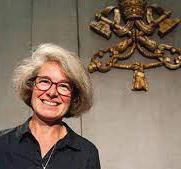
It is striking to hear from so many parts of the world where people had the opportunity to take part in a true synodal consultation, allowing them to pray together, to listen to each other, to dialogue on the fundamental question of the synod, and to experience joy. In fact, many express gratitude saying, “ It is the first time the Church is asking (for) my voice and it makes me realize that we are the Church, not only the priests and the bishops.”
This synod is already bearing fruits, and we can contemplate how the Holy Spirit is leading the Church to a conversion at the grassroots in local churches, embracing synodality with creativity.
Effectively, it is a learning process, a missionary renewal to enter into a new vision of the Church that is a discerning Church, a relational Church, an inclusive Church. In a nutshell, it's a Church on the move, understanding herself as a missionary communion reflecting the mystery of the Trinity.

As many theologians expressed it after the opening of the synod in October 2021, we are living “ the most important ecclesial event after the Second Vatican Council.” In fact, this is the first time in 2,000 years of Church history that a synod is called to involve the entire people of God. So everyone is called to participate, to give his or her voice, especially the poor, those from the margins, the voiceless.
And the conversion to synodality has no end. Therefore, we are invited to continue this crucial journey for the future of the Church and the future of a world longing for peace, reconciliation, and unity. All the baptized have a role to play for promoting and implementing synodality at all levels of the Church. If we believe that “ synodality is the way of being the Church today according to the will of God, in a dynamic of discerning and listening together to the voice of the Holy Spirit,” as stated by Pope Francis, we can be confident that we will receive the grace to answer this call of God to become a synodal Church. ■
The Synodal Journey
The following is an excerpt from a Vatican News story (October 3, 2022) that shares the testimony of the Venezuelan theologian Rafael Luciani, Expert of the General Secretariat of the Synod. The meeting of experts from different parts of the world, held in Frascati, Italy, from September 21 to October 2, is a milestone in the synodal journey that the Church is living.

“ It is a process of listening and discernment,” says Rafael Luciani, associate professor of the practice at the Boston College School of Theology and Ministry and appointed Expert of the Theological Commission of the General Secretariat for the Synod of Bishops. The theologian points out that one of the central aspects that the pope has always manifested is that the Church needs to renew itself, to undertake a path of reform and, for this, this synod is not a responsibility of two or three or of a group, “ but of everyone in the Church,” emphasizes Luciani. In this way, the process will be able to represent the voices, the problems, the concerns, so that the Church can be the Church of listening, of discernment, and derive in making decisions that respond to the signs of the present times.
Luciani notes that the call has had a massive response as never before in the history of the Church, with the participation of people not only Christians but also agnostics and people of other beliefs who have sent contributions to the Secretariat of the Synod…(And) it is about one more link in the way towards a closer Church, more faithful to Jesus.
For more information on Synod 2021–2024, visit: www.synod.va
24 c21 resources | winter 2022/2023
Synodality is the way of being the Church today according to the will of God, in a dynamic of discerning and listening together to the voice of the Holy Spirit.”
— Pope Francis
Synod 2021 2024
ROLES & RELATIONSHIPS
For a synodal Church
communion participation mission
“
Women in Minis ry VOICES
Carolyn Y. Woo, (Retired) President and Chief Executive Officer, Catholic Relief Services
While the dismissal of women is the dominant narrative, I do not hold the view that women’s leadership in the Catholic Church is as rare and out of reach as the perceptions held by many people inside and outside of the Church. In over twenty years of leading two Catholic institutions and serving on boards of about fifteen more, I have interacted with many women who play such roles. These include leaders, founders, and board members in all sectors of Catholic ministries such as K-12 education, higher education, social services, health ministries, pastoral ministries, diocesan administration, clergy formation, communications, and advocacy.
While leadership appointments for women can be significantly expanded, and misogyny still dishonors women and brushes aside their gifts, it is important to acknowledge the inroads that have been made and opportunities that are accessible to women. Perceptions and general criticisms have not kept pace with emerging reality, which points to a notable number of women leading with impact and influence.
Kim Daniels, Co-Director, Initiative on Catholic Social Thought and Public Life, Georgetown University, Washington, DC
Through all this time, I’ve learned from others’ examples that it’s vital for Catholic women to take on leadership roles in order for our Church to bring an effective witness to our troubled world. Pope Francis offers a model for what such witness looks like: lift up the gospel of Jesus Christ; offer humble service to our neighbors; and bring Catholic social principles to public life with mercy and generosity.
While I’ve had great opportunities, it hasn’t always been easy. Clericalism is
real and harmful. Like others, I’ve been dismissed or patronized because of who I am or the views I hold—because I’m a woman, or because I’m a mom of six; because I support Pope Francis, or because of my background doing pro-life and religious liberty work. And seeing the clergy sex-abuse crisis up close has often been discouraging and dispiriting, particularly because it’s clear that had more women been in the rooms where decisions were made, we wouldn’t be where we are today.
But the broken body of Christ is still the body of Christ, the source of our joy and our hope. When I pray the Creed I believe every line is true, and I know that those truths, and the love in which they’re grounded, unite Catholics as a family. I know that around the world the Church still lives out our gospel mission—love of God and neighbor—every single day, celebrating the sacraments and serving the poor and vulnerable. Our Church, as Pope Francis says, is a home with open doors, and I am grateful and humbled to be a part of it.
Jennifer Fiduccia, Director of Leadership Consultants, Catholic Leadership Institute, Philadelphia, PA
The role of leadership as a Christian is to be a servant first. There is no room for ego, personal agenda, exclusion of others, pride, or arrogance. To exercise this role is to lead from wherever I find myself, which means putting myself in the service of others. It means looking at what the needs are and considering how my giftedness and ability intersect with those needs. It often also means putting aside what I want to do in favor of what I am being called to do by God. Being a woman has especially helped me to understand that true leadership does not need a formal title. In the Church, where women are excluded from some of the most prominent leadership roles, I can still live out my baptism in profound ways. I am called
to “make holy” the places and spaces in which I find myself, including my family, social circles, workplace, and community. And I can do this by committing to carrying the light of Christ into every situation. I am called to speak on God’s behalf, watching and listening for God in our world and pointing it out to others. I am invited to teach how God is moving and doing something new, and can do this by accompanying others on their faith journeys, helping them discern God’s presence in their own lives, and ensuring that all people have what they need to grow into the person God created them to be.
Kerry Alys Robinson, Executive Partner and Founding Director, Leadership Roundtable, Washington, DC
I firmly believe that women hold the key to positive managerial reform, the restoration of trust in the Church and Church leadership, and that now is precisely the time when the Church most needs women and what women uniquely have to offer.
The best advice I can offer in times of anguish when the institutional Church fails to live up to its potential or manifests ignoble qualities—clericalism, arrogance, fear, secrecy, sanctimony, prejudice, sexism, or mediocrity—comes from my teacher and spiritual director, a beloved Sister of Mercy, Margaret Farley. She said, “Remember what it is you most love about the Church and membership in it. Name what you love. Claim what you love. It will provide ballast to allow you to navigate with fidelity and focus when you are disappointed and discouraged.” I have taken this advice to heart and highly recommend the discipline. ■
photo credit: The GIVEN Institute
For additional information on women's ministry, visit: bc.edu/c21anniversary20

Celebrating 20 Years | ANNIVERSARY ISSUE 25
In Carolyn Y. Woo’s recent book Rising - Learning from Women’s Leadership in Catholic Ministries (Orbis Books 2022), she discusses the profound impact of women on the Church, despite the existing challenges. Woo features the powerful stories of sixteen women, including her own and those of the authors quoted here. These brief excerpts from the book offer a glimpse into the profound faith, work, and hope of these individuals.
The Joy of Love
Mmany themes cropped up at the recent conference on moral theology and “Amoris Laetitia,” but, according to Lisa Sowle Cahill—an ethicist and professor of moral theology at Boston College—one that stood out was “the gap between received Church teaching and the experiences of families.”
At the conference, which was held at the Pontifical Gregorian University in Rome, Dr. Cahill focused on this discrepancy between teaching and experience in her paper to the conference, which was titled “Complexity of Family Relationships: Social Realities, Pastoral Dilemmas, Moral Understanding.”
She spoke on the topic not only as a moral theologian—who, in her own words, “has a special interest in gender equality, the diversity of cultures and perspectives in the global Catholic Church”—but also as a married woman and mother of five children.

Dr. Cahill acknowledged that in the Church’s teaching in past decades one can see “very rigid and static ideals that are missing some of the good things that are going on in the lives of married couples and families.” Speaking from her decades-long experience of married life, she said, “I see families can involve struggle; there’s pain, there’s disappointment. But in and through all of that there’s still survival, there’s love, there are family bonds, and I think that is the original standpoint of ‘Amoris Laetitia.’”
She noted that “what the Church in the past tended to look at was irregularity or sin or what is not acceptable.”
“Amoris Laetitia,” in contrast, “is about authentic faithfulness, courage, perseverance, real fidelity, and authenticity that is still present in families.”
Pope Francis “frequently gives interviews or makes off-the-cuff remarks that are very striking at times,” Dr. Cahill said, adding that she was “really struck” by what he said about accompanying transgender people during a press conference on an airplane as he returned from Georgia on Oct. 2, 2016. But Dr. Cahill says that she believes his “remarks can be applied more widely.”
The pope emphasized that “not every case is the same, but we have to accompany, we have to discern, we have to integrate, we have to learn, and that is what Jesus would do today.”
“I think that attitude—‘What would Jesus do?’—is the hallmark of ‘Amoris Laetitia,’” Dr. Cahill said. She sees this criterion for applying Church teaching being replicated at the conference, but she has also seen it reflected in recent years; she says that she has seen “a changing perspective” at both the John Paul II Institute for Marriage and Family and at the Pontifical Academy for Life. This is happening, she said, “while staying within the Catholic tradition, of course, and being faithful to those values.
“There’s a broadening of perspective and a widening of the conversation that includes not only marriage and family in the traditional sense but more openness to LGBTQ individuals and their families and recognition that they too are already part of the Church,” Dr. Cahill
26 c21 resources | winter 2022/2023
SEXUALITY IN THE CATHOLIC TRADITION
Gerard O’Connell
Theologian Lisa Cahill reflects on the future of Catholic teaching on sexuality and family life
photo credit : Vatican News
continued. “It’s not that the Church must reach out; they are here.”
She noted that this “widening of the conversation” is something that has developed into “a movement within the Church from Vatican II,” following the publication of Paul VI’s “Humanae Vitae” and John Paul I I’s “Veritatis Splendor” and a subsequent “alienation that has arisen in many cultural situations between the teaching Church and the realities of people who live their lives in families.”
Dr. Cahill said there has “sometimes been the assumption, maybe even of Pope Francis in ‘Amoris Laetitia,’ that all these families are very oppressed by the teachings of the Church, and they are in pain and they want greater room.” But, she said, “what you see in many countries—like the United States, Australia, [and those in] Western Europe—is an alienation of the younger generations. They are not really in pain because they are disregarding what the Church has to say.”
She said this is “so unfortunate.” Although young people sometimes adopt new values that “are an improvement,” Dr. Cahill said, “sometimes [these values] don’t offer much in terms of a moral and value framework with which to encounter the cultures that they l ive in.” She cited so-called hook-up culture and “the very free-ranging sexual ethos” on many U.S. college campuses as one example of a negative development.
Dr. Cahill emphasized, however, that “this doesn’t mean that we need to go back to pre-Vatican II Catholic sexual teaching, or even to Vatican II-era moral teaching. Rather, what we need today is a sensible and Christian perspective on relationships that is viable in the world in which we live.”
But to achieve this, she said, “I think more of a conversation should happen between official Church teaching and its interpreters, and the supposed audience to which it is addressed—recognizing that it is not just an audience that is limited to compliant members of the Church and that multiple voices are important to hear.”
She agreed that with the publication of “Amoris Laetitia,” Pope Francis has opened a door for pastors, moral theologians, and Catholics in general to take a new look at all human questions in the light of Vatican II.
Part of this post-conciliar attitude is reflected in the personal humility of Pope Francis in official documents. “I appreciate that Pope Francis often uses the first person even in official documents: ‘This is what I think,’” she added. “There’s a humility in that and an invitation to join the discussion.”
In “Amoris Laetitia,” Francis “makes a radical return to an old idea but revivifies it in today’s context. He takes the idea from Aquinas that all moral knowledge is practical knowledge and that it always arises in a context,” Dr. Cahill said. “But discernment of what the context requires is necessary before knowledge is authentic and true. And so, in Chapter 8, he quotes Aquinas in saying that if you can have knowledge of a rule or knowledge of a practical reality, it’s the knowledge of the practical reality that is more important than t he knowledge of the rule in terms of making a correct discernment, an authentic discernment, of what is required in a situation.”
“This is not something that Pope Francis has just invented,” Dr. Cahill said. “It goes back in the tradition. But it does present quite a significant and fundamental challenge to the assumptions that many people have about what moral theology is, and how it works, and also how—at the practical level—knowledge of what is right and wrong arises.”
“It’s not that rules are no longer important,” she said, referring to the teachings in “Amoris Laetitia.” “But they have to be constantly retested in the light of the realities and regenerated, re-energized, reformulated, re-appropriated in light of the experience. To me that’s really huge!”
Speaking from her own experience, she said, “I have very strong views about the equality of women, the acceptance of LGBTQ [people] in the Church, a more flexible and bottom-up view of sexual norms and gender norms—yet I don’t feel that I am called to condemn people that come from another experience, that are struggling to find their own voice and to find ways to express their own values in a new way. I think we have, still, to be in consultation.”
She rejoiced at seeing “a newer sensibility and an openness to a different discussion gaining ground and expanding” at the conference. She also expressed the hope this broader discussion can take hold at the international level among Catholics because “often our debates are so European, American, and Western centered,” and not all the issues discussed are necessarily t he issues of concern to Africans, who are a growing part of the Church.
“I just think the global Church has to be much more on the horizon,” she added. At the same time, she said this “makes Pope Francis’s job that much trickier. Because when you start looking at global diversity, the norms around family and gender are also very diverse and not necessarily in keeping with ‘Amoris Laetitia.’”
She notes that people “often say, ‘Pope Francis needs to change the rules to what the reality is.’” But, she said, “he’s the pope of a global church, and I think he’s very aware that the debate in the family synod clearly demonstrated that not every change he might be willing to make would be acceptable in the societies that the African cardinals come from, or indeed some of the other cardinals.
“So, he has a very daunting task making a huge move forward without tipping the boat he’s steering too far to one side or the other and without throwing people overboard,” Dr. Cahill continued. “He’s got to be a leader for t he whole Church, and without being paternalistic, he has to try to keep the family together.” ■
Gerard O’Connell is America magazine’s Vatican correspondent and author of The Election of Pope Francis: An Inside Story of the Conclave That Changed History. He has been covering the Vatican since 1985.
This article is an excerpt of an interview originally published in America magazine on June 3, 2022, and is reprinted with permission.
Celebrating 20 Years | ANNIVERSARY ISSUE 27
Lisa Fullam
walk into a school of music and observe the man in his forties just learning the violin. He struggles a bit with tone and pitch, and his fingers still get sore from the strings, but he wants to be able to express himself musically in the mode that the violin allows. He devotes himself to practice so that he may be not just a man learning the violin, but a violinist.
W thou shalt: Sex Beyond the List of Don’ts
The virtue ethics of Thomas Aquinas are about this kind of process. In this approach, virtues are defined as “perfections” of our natural capacities, not just for certain types of activity but for human moral life as a whole. Aquinas follows Aristotle, who noted that we “become builders by building and lyre players by playing the lyre; so too we become just by doing just acts, temperate by doing temperate acts, brave by doing brave acts.”
What happens when we apply this very traditional mode of ethical reflection to the questions of sexual ethics? The morality of sex has long been the focus of Christian teachings—and prohibitions. I propose a threefold end or goal, a telos, that might be a starting point for a new conversation about sex.
Christian ethical reflection on sex has tended to focus on what makes individual sex acts morally right or wrong. This view of sex that looks at acts objectively and tends to regard anything sexual as probably sinful has resulted in a rule-focused sexual morality generally expressed as lists of don’ts: Don’t masturbate. Don’t have sex before marriage. Don’t use contraception when you have sex in marriage. Don’t have sex outside marriage. Don’t have sex with someone of your own sex. Don’t abuse others sexually. I’m not dismissing these don’ts out of hand: some don’ts are of great value, some are less valuable, and some are grounded in bad biology, bad psychology, or bad theology and should be discarded. But to limit our ethical talk of sex and sexuality to t he don’ts is a theological and also a spiritual error, not unlike limiting a discussion of Christian life to talking about sin.
A goal we might seek in our sex lives, I suggest, may be described in three dimensions: a feel for incarnation,
an ability for intimacy, and an eye for insight. I’ll describe each of them, but they work together like a trinity—three aspects of one reality. I invite you to examine this proposal in light of your own feelings, beliefs, understandings, and experiences.
INCARNATION
Incarnation is a central motif of Christian anthropology. We speak of Jesus as God incarnate, but the very notion that God can be fully human, like us in all things but sin, is a bold proclamation of the ineradicable goodness of human embodiment generally—not just Jesus’ i ncarnation but our own. We are not spirits trapped in matter; neither are we mere matter that has stumbled into self-awareness. Rather, Christian tradition holds that we are incarnate spirit, an indivisible body-soulspirit composite. When we are lost in sexual passion, there’s usually not a lot of thinking going on—we are taken up in our bodiliness. Certainly pleasure is one of the obvious ends we hope for in our sex lives: there is a huge array of sexual pleasures, and pleasure by proxy, as it were, when we delight in the delight of our partner.
Developing a feel for incarnation includes mutual pleasure, and goes further. A sense of our incarnate selves leads us to pay attention to our overall well-being—physical, emotional, and spiritual.

INTIMACY
Intimacy is a central goal of sex. Like the other dimensions of excellent sex, it’s a goal because it cannot be taken for granted, and because it is something that can deepen with attentive practice. Intimacy is not a yes or no question, but a matter of depth and degree. In a minimalist list of don’t ethics, so long as you meet the minimal criteria for permissible sex, all guidance ceases. But a married couple not breaking any “rules” might still struggle with a lack of intimacy and fulfillment in their sexual relationship.
Intimacy as one of the three aspects of excellent sex is related to incarnation—sex expresses a personal reality,
SEXUALITY IN THE
TRADITION
CATHOLIC
not only a bodily one. At the same time, it calls us to an emotional and psychological openness and vulnerability that can be far more challenging than just physical sex. One of the virtues cultivated in what Christian ethicist Karen Lebacqz called “appropriate vulnerability” is trust. A person who shies away from vulnerability will never know the freedom that can come through trusting another person with our bodies, thoughts, feelings, and desires. To be accepted by another in this intimate way in turn contributes to the third dimension of excellent sex, which is an eye for insight.
INSIGHT
Insight means more than just perception; it implies a deeper level of cognition. While an observation like “she moved out” is a matter of objective fact, the evaluation “she doesn’t love me anymore” is a deeper awareness of a fuller—and more painful—human meaning behind the observed act.
It is insight that invites us to see the echoes of our relationships beyond the immediacy of partners to include family, society as a whole, and our relationship to God. Insight allows us to come to a better understanding of how sexual relationships have played out in our lives in the past, and how we might use that experience in present and future relationships. Insight calls us to cultivate t he virtue of compassion for our own mistakes and those of others, and to be committed to what sustains stronger intimate relationships. Insight reveals connections that may not have been apparent and sharpens our vision of what might be.
Insight is especially engaged when we begin to catch the echoes between our sexual lives and our spiritual lives. Christian tradition has tended to associate spirituality with sexual abstinence, but to think of sex as opposed to spiritual excellence or as inhibiting spiritual growth is inconsistent with a true understanding of our incarnate nature.


The list of virtues for excellent sex, of course, doesn’t end with those I’ve mentioned here. The triune

end of incarnation, intimacy, and insight is sought via a panoply of virtues, ranging from patience, humility, and forgiveness to honesty, attentiveness, and playfulness. And the wonder of it all is that it is exactly in the pursuit of excellent sex that we discover the particular contours and textures of the form it will take in our own lives, just as in each generation Christians incarnate the faith anew, responding to the voice of God as we and those who’ve gone before us have discerned it. In excellent sex, we celebrate that we were created by Love, to be love, and make love in the world. ■
Lisa Fullam, D.V.M., Th.D., is professor emerita of moral theology at the Jesuit School of Theology of Santa Clara University. She is the author of The Virtue of Humility: A Thomistic Apologetic.
Originally published April 20, 2009, Commonweal magazine. Reprinted with permission in C21 Resources— Intimacy and Relationships in Catholic Life (Spring 2014). Guest Editors: Lisa Cahill and Kerry Cronin
The C21 Center published an award-winning book series, drawn from conferences and symposia held at Boston College.
Included in the C21 Book Series are: Love One Another and Sexuality and the U.S. Catholic Church. Email church21@bc.edu for more information on these resources.
“
SESQUICENTENNIAL
Celebrating 20 Years | ANNIVERSARY ISSUE 29
To limit our ethical talk of sex and sexuality to the don’ts is a theological and also a spiritual error, not unlike limiting a discussion of Christian life to talking about sin.”
ISSUE Intimacy and Relationships in Catholic Life
Witness to LOVE
Mary-Rose Verret
Mmarriage is a vocation in crisis. Like dusty crocheted doilies or dial-up telephones—perhaps they were b eautiful, useful, or sentimental once, but not today. Sacramental marriage rates plummet year after year and the response often given is that we need to require more of couples getting married. What if the answer was already in the hearts of young people and in the witness of married couples?
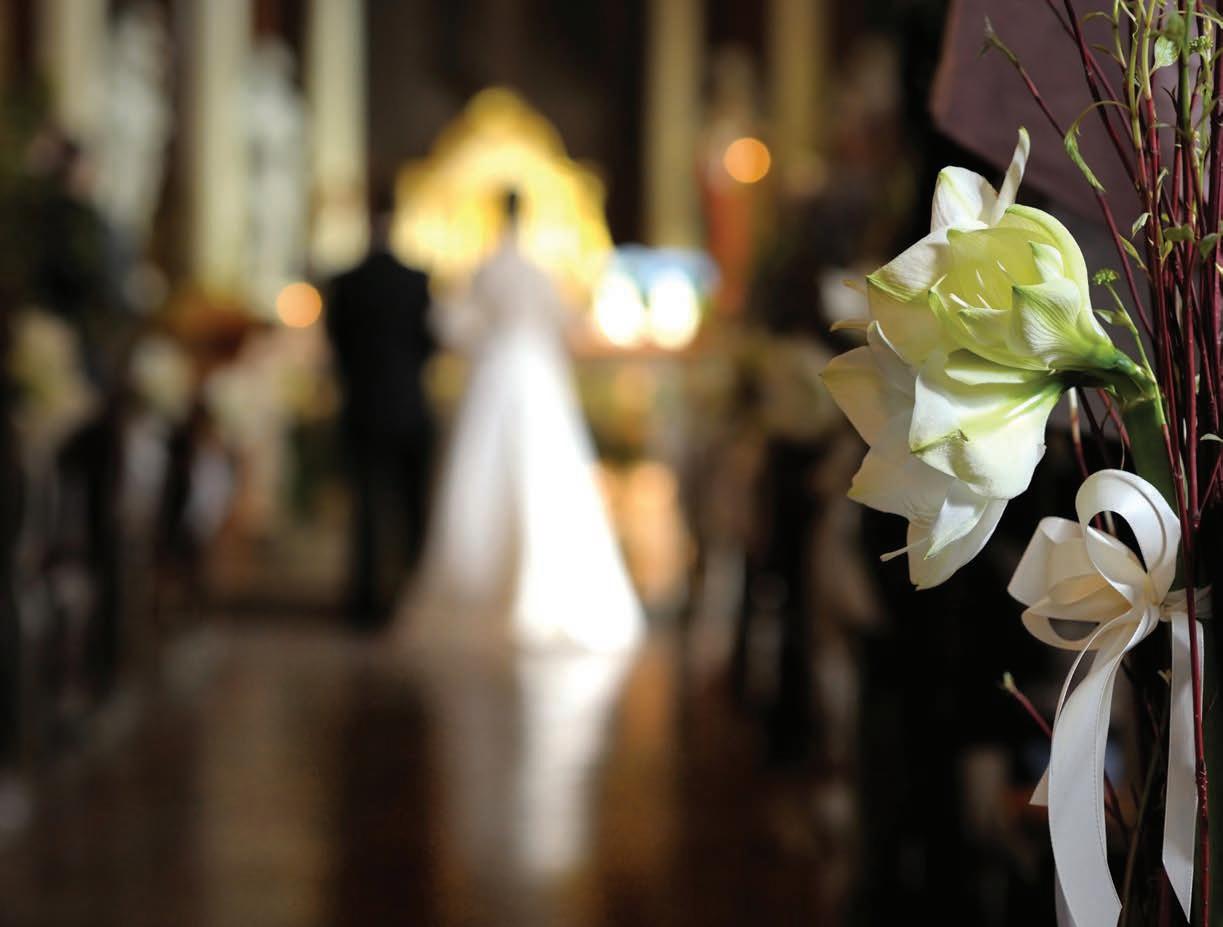
What would draw two nominal Catholics to decide to have a sacramental marriage in the Catholic Church? Today, they would be a minority among their friends and peers, if they choose marriage at all, and especially if they choose to be sacramentally married. Over the years, we have met thousands of couples and heard hundreds of stories. The following is my favorite story because it illustrates how God is still calling deep in the hearts of young people to the vocation that reveals God’s love to the world. Just like in the Chronicles of Narnia , there is that turning point when the snow begins to melt and the winter which lasts for years loses its grip—we have seen that there is a springtime and there are stories to be shared.
On a sticky, hot day in Los Angeles, a group of preteen boys ran into an unlocked church to cool off and accidentally interrupted what they later realized was an Alcoholics Anonymous meeting. The priest leading the meeting quickly ushered them out of the church but gave them each a holy card with the Our Father prayer on the back. He asked the boys to say this prayer every night. Rich was one of those boys, and he and his brother had recently become fatherless. For this twelve-year-old, the prayer became something of a lifesaver. He took out the card and said this prayer every night for fifteen years, and God began to work in his heart. He grew up and moved across the country, but he still said the familiar prayer every night. Many years later, he was working at a bar in Maryland during a heavy snowstorm.
The night of the epic snowstorm, a young lady named Jessica, who had recently gone through a painful marital situation and subsequent annulment process, walked in to play pool with some friends to get out of the snow. Rich and Jessica found out they came from the same town in California. Jessica and Rich became friends and later started dating. They each shared with
30 c21 resources | winter 2022/2023
SEXUALITY IN THE CATHOLIC TRADITION
the other their personal journey. Jessica had been in a very unhealthy relationship, and that was all she had known. She left California to get away and to start a new life.
Rich shared with Jessica his journey and how he had no connection to any church, but he did have a connection to God through the daily prayer that had been h is anchor. Together, they found in the other something that reflected God and they became engaged. They decided to get married in the Catholic Church because it had become obvious that their marriage belonged to God and that their Father in heaven had drawn them there together. The parish they began the marriage preparation process with in Maryland was a Witness to Love parish. The parish asked them to choose a mentor couple whose marriage they admired, who could walk with them on their journey, but they initially couldn't think of anyone. Back home, at a Christmastime engagement party in California, they reconnected with a beautiful couple they both knew from their hometown years ago. Henry and Elizabeth became mentors to this young couple on their journey.
They began the Witness to Love process of meeting and sharing lives, growing in virtue, attending church, and building a deep bond with this mentor couple. Over the months, Henry began to go blind because of a health condition and did not want to cause Rich and Jessica any anxiety leading up to the wedding. He pretended to be able to read along with them, but in reality Elizabeth had read all the materials and discussion questions to him before each meeting. Closer to the wedding day, the engaged couple discovered that Henry was, in fact, completely blind. The gift that Henry had given to them in the sacrifice, the extra difficulty of trying to mentor while dealing with a health crisis and being unable to read, blew them away. This was love in action! How could their mentors care so much for them?
On the day of their wedding, there was a quiet moment between Rich and Henry. Henry let the new groom know that he was the son he never had (Henry and Elizabeth had three daughters). Rich said, “Henry, you are the answer to the prayer that I have been praying all these years. You are the father I never had.” Rich told him about the “Our Father” prayer card he was given decades ago.
Generosity breeds generosity, kindness breeds kindness, and God is involved intimately in the details of our lives. Through this journey, both couples were renewed in the gift of Christ’s presence in the Sacrament of Marriage, in the gift of friendship, and in the gift of being fully alive to whom God created them to be. ■
Mary-Rose Verret, together with her husband, Ryan, is an internationally recognized speaker, author, and television host, and co-founder of Witness to Love, a marriage movement renewing the Church through relationships.
In June 2021, the Verrets were invited by the Vatican to present at the international forum “Where Do We Stand with ‘Amoris Laetitia‘?” and at the World Meeting of Families in Rome in 2022. Their passion is teaching couples to share their marriage with others and to understand that their home is a missionary outpost of the local parish. Their latest book, Family Missionary Discipleship: Forming Marriages and Families to Share the Joy of the Gospel, will be released in 2023.
For more information on the Witness to Love programs and publications, please visit: witnesstolove.org

in response to Pope Francis‘s call to engage young couples and provide new models for formation as they approach the Sacrament of Marriage, the Vatican‘s Dicastery of Laity, Family, and Life published a new pastoral guideline, “Catechumenal Pathways for Married Life” (CPML), in June 2022. To learn more about the CPML, “Amoris Laetitia” (AL), and additional resources for marriage preparation, visit: bc.edu/c21anniversary20
“Neither of the spouses will be alone in facing whatever challenges may come their way. Both are called to respond to God’s gift with commitment, creativity, perseverance, and daily effort. They can always invoke the assistance of the Holy Spirit who consecrated their union, so that...grace may be felt in every new situation that they encounter.” Pope Francis (AL 74)
Celebrating 20 Years | ANNIVERSARY ISSUE 31
“What would draw two nominal Catholics to decide to have a sacramental marriage in the Catholic Church?”
photo credit : istockphoto.com—MNStudio
A Wondrous Adventure
The Catholic Intellectual Tradition
Fr. Robert P. Imbelli
“The Catholic Intellectual Tradition is the centuries-old effort to understand the Mystery of faith more fully—its scope and implications—and to live it more faithfully.”
W
when i was growing up, “Mystery” was often presented as “incomprehensible” and portrayed as a red light before which understanding must stop. But in a more authentic Catholic view, Mystery signifies “inexhaustible”—like a blinking yellow light that signals us to proceed with reverence.
But the Mystery which the Catholic Intellectual Tradition ponders and seeks to appropriate more fully is “the Mystery of Faith.” Recall the celebrant’s proclamation after the words of consecration in the Eucharistic Prayer. The “Mystery of Faith” is the Paschal Mystery of the Lord Jesus: his death, resurrection, and ascension.
Note: we seek to understand the Mystery of Faith. For the Catholic Intellectual Tradition, faith and reason are not antagonistic, but deeply complementary, indeed mutually enriching. In the words of Pope St. John Paul II, they are the two wings by which the human mind soars to God.
At the same time, the “thinking” entailed is not neutral and detached. It recognizes that the person seeking is himself or herself an active participant. They themselves are co-involved in the quest: their own meaning and purpose at stake. Hence “devotion” and prayer are essential to the exploration of the Catholic Intellectual Tradition. It is a matter not only of the mind but of the heart as well. As Pascal passionately exclaims: “the heart has its reasons that reason does not grasp.”
But this leads to what is, perhaps, the crucial point. We hear often that there are three great “religions of the Book: Judaism, Christianity, and Islam.” There is some truth to the assertion, and it can serve as a valuable point of entrance into dialogue among the three religions. But, upon deeper consideration, it misses what is most distinctive about Christianity.
Christianity is not at its heart a religion of the Book, but of the Person: the Person of Jesus Christ. Thus
Robert Wilken is entirely correct when he writes: “After the coming of Christ, human reason had to attend to what was new in history, the person of Jesus Christ” (The Spirit of Early Christian Thought: Seeking the Face of God).
This sense of the newness, the novum, of Jesus Christ permeates the New Testament. It proclaims the “new covenant,” the “new creation,” the “new Adam,” the “new Jerusalem.” And the Catholic Intellectual Tradition takes up joyfully the refrain. It is the centuries-old effort to understand this new reality more f ully—its scope and implications—and to live it more faithfully. Already in the second century, St. Irenaeus of Lyons sounded the theme whose variations will resound through the centuries: “Christ brought all newness in bringing himself!”
It would be useless to deny that we face here what has been called “the scandal of particularity.” A specific individual, who lived two thousand years ago, in a backwater town of the great Roman Empire, who was murdered by that empire as a rebel against Caesar in one of the most gruesome and degrading forms of execution ever devised by human “ingenuity”—that man is the very Incarnation of the living God. Jesus Christ, crucified and risen, is Emmanuel: God with us!
We should not allow the beauty of a Gregorian chant or a Mozart Mass, the majesty of the theological work of a Thomas Aquinas or a Hans Urs von Balthasar, the splendor of a great cathedral or the painting of a Michelangelo to camouflage that reality. The One who has been disfigured and defaced is the human face of God.
As St. Peter puts it in the first proclamation of the Gospel on the day of Pentecost: “This Jesus, whom you crucified, God has raised from the dead and enthroned him at his right hand. From there he sends the Holy Spirit upon us” (Acts 2:32–36).
Thus, at the center of Christian faith and of the Catholic Intellectual Tradition is the Cross, which faith sees not as an instrument of death but as the Tree of New Life. The twelfth century mosaic in Rome’s Basilica of San Clemente (shown in this photograph) magnificently depicts the life-giving Cross. From the Cross of Christ flow living waters that irrigate a flourishing acanthus bush, whose branches enfold human beings and animals in peaceful harmony.
What our Tradition ponders and celebrates, then, is a comprehensive, a Catholic, vision of reality: a new understanding of God, of the human, of the universe.
In contrast to a secularism that is often one-dimensional, that reduces reality to the merely this-worldly, to what we can control and manipulate, the Catholic Intellectual Tradition proclaims that the world is “sacramental”—that it is created by God and therefore has an intrinsic worth. At the same time, the world points beyond itself to the God who creates and sustains it. As the nineteenth century Jesuit priest and poet Gerard Manley Hopkins exclaims: “The world is charged with the grandeur of God!” The world and earthly things are not idols to possess, but icons to respect and be grateful for.
32 c21 resources | winter 2022/2023 CATHOLIC INTELLECTUAL TRADITION
Moreover, it affirms that God created the world not out of some need or necessity, but out of sheer goodness and grace. God does not need the world and humanity to be God. God is the Triune God. The God Christian faith worships, the God whom the Catholic Intellectual Tradition seeks reverently to know more fully and intimately, is God, Father, Son, and Holy Spirit.

For the Mystery of the Trinity is not a mathematical puzzle, but the fullness of life and of love. The “Tri-personal” God is in terpersonal communion, who reveals what it truly means to be person-in-relation.

Humankind, created in the image of this God, redeemed and given new hope by the death and resurrection of Jesus Christ, h as immense dignity. We are not waiting aimlessly and hopelessly for Godot. For we are convinced that “God so loved the world that he gave his only-begotten Son” (Jn 3:16). Hence human life, from conception to natural death, has meaning and purpose.
But this dignity and grace also carries great responsibility: To enter into and promote a com munion of love. To foster what Pope Francis calls an “integral ecology” that embraces individual, community, and care for the environment, our common home.
The Catholic Intellectual Tradition thus focuses not only upon the individual (as does so much of secular culture—“I did it my way . . .”), but upon the community: the “we” of the Church, the communion of persons. The Holy Spirit works to create communion, to teach the language of “we”—a lifelong learning process!
Thus the Catholic Intellectual Tradition insists that Catholicism is not a private affair, a merely personal feeling or preference, but that it has intellectual substance and public importance. Separation of Church a nd State does not signify the divorce of faith from the public realm. Those who say that “faith and politics do not mix” have not paid sufficient attention to the prophets of Israel or to Jesus’ “Sermon on the Mount.”
In a famous address, Dr. Martin Luther King, Jr., affirmed his belief that, “the arc of the moral universe is long, but it bends towards justice.” In many ways the Catholic Intellectual Tradition can be understood as a commentary on that phrase.
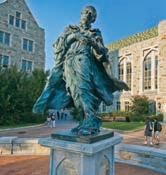
It celebrates its foundation in the Paschal Mystery of Jesus, who was put to death unjustly, but raised to life by the God of Justice. It explores its implications in
what we owe to God and to our fellow human beings. It often can take a “counter-cultural” stance, for it resists a culture of mindless consumption (what Pope Francis calls a “throw-away culture”), the idolatry of wealth and power, and the commodification of human beings by the exploitation of labor or engaging in sex trafficking. It denounces the many ways our culture defaces human beings—even when they are hidden in the womb. However, based on the Catholic Intellectual Tradition, we might offer a further amplification of Martin Luther K ing’s insight. For beyond Justice (however imperative) is Love that is never a right, but always a Gift. “The arc of the universe is long, but it bends toward Love.”
One can catch here an echo of the Catholic tradition’s greatest poem, Dante’s Divine Comedy. At the end of Dante’s perilous journey, he finds fulfillment in a life-giving vision of the Blessed Trinity. And the poem ends in awe and adoration before “the Love that moves the Sun and the other stars.” The whole of the universe is caught up in the God who is Love.
This is the wondrous vision that the Catholic Intellectual Tradition ceaselessly celebrates and explores. Welcome to the adventure! ■
Fr. Robert P. Imbelli is a priest of the Archdiocese of New York and associate professor emeritus at Boston College. He is the author of Rekindling the Christic Imagination: Theological Meditations for the New Evangelization.
This lecture excerpt is printed with permission of the author from the University of Notre Dame’s Church Life Journal , January 3, 2017.
Guest Editor:
Fr. Robert P. Imbelli
Celebrating 20 Years | ANNIVERSARY ISSUE 33
iSSue spring 2013
Exploring the Catholic Intellectual Tradition
SeSquicentennial
Read C21 Resources— Exploring the Catholic Intellectual Tradition (Spring 2013).
Gregory A. Kalscheur, S.J.
D Critical Challenges for Catholic Higher Education
determined to clarify their Roman Catholic identity in the face of potent secularizing trends and concerns that they had sacrificed their Catholic distinctiveness for secular academic respectability, Catholic colleges and universities in the United States over the past 20 years have adopted new mission statements and added personnel and programs designed to reemphasize the religious dimensions of the Catholic college experience.
Today at many Catholic colleges, students and parents find explicit attention to the Catholic nature of the institution: a wide variety of programs aimed at students’ spiritual and religious formation, numerous well-attended Masses and retreat experiences geared to young adults, service programs reaching out in all directions, and encouragement of students to discern not only what career they will pursue after college but what kind of persons they will become. More and more Catholic college undergraduates are being challenged to explore the vocation in life to which God is calling them.

But this rich set of opportunities for student personal, spiritual, and religious formation seems not always to have been matched by a parallel interest in and emphasis on reaffirming and revitalizing engagement with the Catholic Intellectual Tradition. As Pope John Paul II explained in Ex Corde Ecclesiae , his 1990 vision of what a Catholic university should be, the special intellectual legacy of the Catholic university “is distinguished by its free search for the whole truth about nature, man, and God.” Rather than exploring the implications of this dynamic legacy, discussions of Ex Corde Ecclesiae sometimes seemed more inclined to focus on presumed tensions between maintaining academic freedom and protecting orthodoxy. One could get the impression that not inviting certain speakers, not honoring certain public officials, or not hiring so many non-Catholics was more important than encouraging the university community to engage the full range of authentically human questions
opened up by a commitment to pursue the whole truth about nature, the human person, and God, wherever that search for truth might lead.
Ten years after Ex Corde was formally adopted by U.S. Catholic bishops in 2001, Catholic colleges and universities today must meet the challenge to reaffirm and revitalize their engagement with the Catholic Intellectual Tradition. Failure to do so will mean that they are content by default to risk leaving Catholic identity to what happens outside the classroom by abandoning the conviction that, to be authentically Catholic, they must integrate their 2,000-year intellectual legacy into the academic life of their campuses.
Admittedly, getting hold of the Catholic Intellectual Tradition is a challenge. It contains a vast repository of theological thought; philosophizing; devotional practices; works of literature, visual art, music, and drama; styles of architecture; jurisprudential principles; social and political theorizing; and other forms of cultural expression that have emerged in vastly different parts of the world in the course of 2,000 years of Christian religious experience.
For Christians, the dialogue between faith and culture is as old as their earliest efforts to articulate what it means to be a distinctive faith community. As the Christian way moved beyond its original Jewish communities, attracted Gentile converts, and spread across the Roman world and beyond, a Christian intellectual tradition developed, which was the product of a continuous dialogue between faith and cultures.
This dialogue reflected two essential characteristics of the Christian, and especially the Catholic, understanding of human experience: that faith necessarily seeks understanding, and that all intellectual inquiry leads eventually to questions of ultimacy that invite faith responses. As a result, reason has been intrinsic to the life of the Catholic Church, which sees the search for truth as
CATHOLIC INTELLECTUAL TRADITION
34 c21 resources | winter 2022/2023
a manifestation of the Creator. For the Catholic, thinking is part of believing, and the Catholic view sees no conflict among faith, knowledge, and reason; it looks to how they illuminate one another. The most probing questions in every discipline are never deemed to be in opposition to faith, but are welcomed into the conversation on the conviction that ongoing discovery of the intelligibility of the universe will reveal more of the truth about God.
In the words of Pope Benedict XVI, “The world of reason and the world of faith—the world of secular rationality and the world of religious belief—need one another and should not be afraid to enter into a profound and ongoing dialogue, for the good of our civilization.” This is a two-way process. Reason plays a purifying role within religion, while religion supplies a corrective to reason, reminding reason to take full account of the dignity and destiny of the human person.
At my own Jesuit, Catholic university, we’ve tried to invite people to enter into this expansive dialogue in search of truth, meaning, and justice through the publication of a document entitled The Catholic Intellectual Tradition: A Conversation at Boston College . Our hope is that the search for truth in all disciplines can be enriched by engagement with the tradition, because it is our conviction that, in the words of the Jesuit poet Gerard Manley Hopkins, “[t]he world is charged with the grandeur of God.”
The Catholic Intellectual Tradition is at work whenever questioning in any field is open to moving out of narrow disciplinary isolation and toward the horizon of human dignity, the common good, and the wholeness and fullness of life that the Christian tradition calls God’s reign. The Catholic Intellectual Tradition that flows out of this dialogue is a living tradition, not a static traditionalism, which draws from the riches of the past to give life to the future; a simultaneous capacity for continuity and change gives it a growing edge, allowing it to develop in new ways even as it retains its firm roots in the foundational Catholic worldview. In the Catholic university, wisdom accumulated in the past is handed on, criticized, reworked, and re-appropriated in response to new questions prompted by new experience, new evidence, new arguments, and new interlocutors. This way of proceeding gives life to the Catholic Intellectual Tradition.
A university animated by the Catholic Intellectual Tradition embraces all who are dedicated to learning from one another, and remains open to contributions that may come in a range of ways. This persuasion challenges a Catholic university to engage all people, cultures, and traditions in authentic conversation—conversation undertaken in the belief that by talking across traditions we can grow in shared understanding that opens all parties to the possibility of changing their views.
In my own work at Boston College Law School, I drew on the Catholic Intellectual Tradition in exposing my Civil Procedure students to Martin Luther King’s “Letter from the Birmingham Jail” and its discussion, informed by Augustine and Aquinas, of the natural law understanding of the difference between just and unjust laws. I ask those same students to think about what sort of person they are becoming and what sort of world they are shaping as they learn to use the power
and the legal tools that our procedural system makes available to lawyers. I also offer a seminar on Catholic Social Thought and the Law that allows students to explore the Catholic vision of the person, the relationship between the person and society, and the role played by law as an institution in structuring the good or just society. But a Catholic university’s engagement with the tradition must go beyond the content of any particular course. The shared project of the university is enlivened by the tradition whenever faculty and students across the disciplines begin to understand themselves as more explicitly engaged in a conversation with one another and with seekers of truth around the world and across time, together working toward the freedom, wholeness, and fullness of life that God desires for God’s creation.
Over the long history of the tradition, there have been times when the dialogue between faith and reason has been difficult—times when Church teaching and secular scholarly research have stood in tension. During such times, the tradition, at its best, has urged more careful inquiry on both sides, confident that even though “there may be momentary collisions, awkward appearances, and many forebodings and prophecies of contrariety,” as Cardinal John Henry Newman, the great 19th-century scholar, has put it, the unity of truth will ultimately be seen.

Catholic colleges and universities today must build upon the good work they have done in providing rich formational opportunities to their students by enlivening engagement with the Catholic Intellectual Tradition on their campuses, thus living up to the deepest meanings and aspirations of the Catholic university.
American higher education and society will be enriched by Catholic universities embodying in our national conversation the Catholic intellectual ideal of a mutually illuminating relationship between religious faith and free intellectual inquiry. ■

Gregory A. Kalscheur, S.J., is the dean of the Morrissey College of Arts and Sciences and professor of law at Boston College.
This revised article was originally printed in C21 Resources (Spring 2013).

Celebrating 20 Years | ANNIVERSARY ISSUE 35
Explore more (and encourage conversation) regarding the Catholic Intellectual Tradition with this video series and accompanying guides on the C21 Center website:
The Catholic Intellectual Tradition: A Conversation at Boston College
photo credit : Courtesy of Gary Wayne Gilbert, Boston College
bc.edu/CIT CATHOLIC INTELLECTUAL TRADITION
Finding God in the catholic imagination
Paul Mariani
Llet ’s begin with lines Gerard Manley Hopkins wrote some 135 years ago, though the words are as fresh today as they were when he wrote them. News that stays news was how Ezra Pound defined the special quality of successful poetry. To which a poet like Fr. Hopkins, working within the powerful tradition of the Catholic/ Christian imagination, would add, Good News that remains always Good News.
A Jesuit scholastic winding up his classes in theology—Dominican Thomism, laced with his brilliant i nsights into the heart of Franciscan Scotism—Hopkins was just months away from ordination when he wrote the untitled sonnet known by its first line: “As kingfishers catch fire, dragonflies draw flame.” What he caught i n this poem was nothing less than the very doing-be, the essential inscape of the thing, the brilliant ignition of Creation caught in daylight, sunlight, God’s light as it were, enacting the splendor of nature’s myriad selves, unselfconsciously, there to be caught or not by the human observer as something to be admired, wondered at, and its Creator praised. Two Oh! moments of recognition in one line, connected by the recurrent ks and f s and ds of the words flashing together. A kingfisher diving from a branch and hitting the water of a stream, say, as the sun hit it slant, so that the iridescent blues and reds and speckled grays of the bird’s feathers suddenly seemed to catch fire.
A scientist looking at a kingfisher might see it as a small-to-medium-sized brightly colored bird of the order of Coraciiform, divided among river, tree, and water kingfishers, all with large heads; long, sharp, pointed bills; short legs; and stubby tails.
But Hopkins wants to catch something more. Not an Audubon specimen to be stretched out on a drawing board and studied, but a living creature, caught by the eye and not the net as something to be admired for the distinctive thing it is, its brilliant colors bursting into flame.
So too with the smaller dragonfly, its wings beating incredibly fast as it darts among the lily pads of a pond, say, on a summer morning, its brilliant colors rainbowing there before us to witness to. But because Hopkins was an artist who loved to sketch, trying to capture the active inscape of the thing his eye caught there, the doing-be of the thing, he puns here, seeing the dragonfly as if it were drawing with flames across the canvas of the summer air.
Kingfishers and dragonflies, caught perhaps one summer afternoon when Hopkins had gone down to the Clwyd in the Welsh vales near St. Beuno’s, where he pondered his Thomism.
Which got him to thinking not only about what we see, but about what we hear, like the distinctive plunk of a rock as it falls into a stone well along which it has rested for who knows how long. But alive now, alive with motion, as it strikes the water like and unlike the kingfisher. Or the pizzicato plunk of a stringed instrument—violin, viola da gamba, mandolin, guitar, piano, h arpsichord, or fiddle—the taut wires suddenly come alive with the instant strike of hammer or finger or bow.
Which is like and distinctively unlike the way bells in belfries and campaniles will ring out in every small shire and university town and great city like London, each shaped to ring out its distinctive sound, alone or as part of a larger harmony. Each thing, then, doing what it was made to do, whether made by mortals, or—better—by the great God Creator.
But Hopkins’s Catholic imagination is far from finished with this meditation. If everything—from stones to kingfishers—“Selves—goes itself; myself it speaks and spells,/ Crying What I do is me: for that I came,” then what about each of us? What I do is me, we are reminded. And for most of us the words that immediately follow will resonate: for that I came.
There are at least 15 places in the New Testament where those words are spoken, by Jesus or describing Jesus. Most dramatically, perhaps, is the moment when Jesus, scourged and beaten before being brought back before the Roman procurator, Pontius Pilate, tells Pilate point blank that he has come into the world “that I should bear witness to the truth.” Or, as he told the crowds to whom he spoke: “I have come as a light into the world, that whoever believes in me should not abide in darkness.”
The light shining on us, the Light gracing us, is what the sacral imagination sees in the quotidian round of things, so that we kiss our hand to the Creator when it dawns on us who and what the Creator is and who we his creatures are. And what are we, then, if not images of Christ as the Father sees us, each of us being Christ in the world, in ten thousand or a hundred thousand or a billion billion places, who play now (act, enact, imitate, and romp about) in the profound mystery of sons and
36 c21 resources | winter 2022/2023
CATHOLIC INTELLECTUAL TRADITION
daughters before the Creator, “Lovely in limbs, and lovely in eyes not his/ To the Father through the features of men’s faces.”
How many Christian artists and musicians and singers over the past two millennia have taken up musical instrument or paintbrush or chisel or pen or pieces of bright mosaic as, say, in the Basilica of San Clemente in Rome, just yards from the Colosseum, with its extraordinary mosaic of the Tree of Life, where the cross itself—that image of suffering transubstantiated into victory and joy—is rooted in the very earth from which we all sprang, and which flowers now, embracing all of God’s creation in its mothering branches: bird, beast, and humankind.
It is what the Catholic imagination adds to the reading of Creation, then, whether in the ancient Psalms or t he Evangelists or Augustine or Dante or Dame Julianna of Norwich or John of the Cross or Shakespeare or Cervantes or Donne or Herbert or Hopkins or Eliot or Péguy or Claudel or Merton or Levertov. Or—more broadly—what it looks for in whatever and whoever it meets, seeking for what it finds there that can offer substance, filtering it as needed, like water from different sources, whether the one heeded be Herodotus or Plato or Aristotle or Propertius or Pater or Rabelais or Baudelaire or Rimbaud.
It’s all there, all those treasures for the taking: in the stained glass windows of our churches and cathedrals; in the stones shaped and fitted patiently, lifting higher and higher no matter the cost in time and effort; in plainchant; in Bach and Mozart and the Congolese Missa Luba; in the earliest images of the Good Shepherd, based as much on the myth of Hermes as on the Hebrew Psalms, but reconfigured now in a new imagination, solidly rooted in the things of this world—earth, rock, fire, water, sky—but lifted by the Father and the Son and the Holy Spirit, who bodes and abides behind it all, through and with and in Him, as one sings at the culmination of the Eucharistic Prayer, and the world once more shivers to wakefulness to embrace the Mystery. ■

As kingfishers catch fire, dragonflies draw flame; As tumbled over rim in roundy wells Stones ring; like each tucked string tells, each hung bell’s Bow swung finds tongue to fling out broad its name; Each mortal thing does one thing and the same: Deals out that being indoors each one dwells; Selves—goes itself; myself it speaks and spells, Crying What I do is me: for that I came.

Í say more: the just man justices; Keeps gráce: that keeps all his goings graces; Acts in God’s eye what in God’s eye he is— Chríst—for Christ plays in ten thousand places, Lovely in limbs, and lovely in eyes not his To the Father through the features of men’s faces
— Gerard Manley Hopkins, S.J.
Paul Mariani is an American poet, author, and university professor of English emeritus at Boston College. His most recent publications include t wo poetry books, Ordinary Time (2020) and All That Will Be New (2022).
Watch Paul Mariani discuss how poetry has influenced his believing heart and mind, and how writing has affected his faith: bc.edu/c21anniversary20
Celebrating 20 Years | ANNIVERSARY ISSUE 37
photo credit : Albert Beukhof / Adobe Stock
the gift of Education and the Intellect
 Fr. Michael J. Himes
Fr. Michael J. Himes

“ if you think of our education as a gift given you to be grasped, as something that you’ve achieved and will hold onto, if you think of your education as a training to make more money or get a better job, if you think that your education is all about your success in being able to provide for yourself and your family, all of which are great and wonderful goods, but if you think that’s what’s central to your education, then I must say that I think you’re unworthy of your education. The reason to be educated is to teach somebody else. You’ve never fully
HOW OR WHERE DO YOU SEE GOD?

g rasped the fruits of your education until you give it away to another. The measure of the success of your education is the measure to which people who never got to come to Boston College, the measure to which their lives are richer, fuller, more genuinely human because you did go to Boston College; that it’s enabling you to give something to others. And in that process, for the first time, you will fully possess it. You never own what you don’t give away. And what you do give away you can never lose.” ■
Over the past few years, following the release of the children’s book Drawing God, the C21 Center has had the opportunity to connect with thousands of kids across the country and around the world about how they imagine God. What does God look like? What does God feel like? Who is God? These are big questions for all of us, but the words, drawings, and imagination of these children are a powerful reminder of how we all see God differently. On the C21 Center website, we share some of their visions and interpretations with you, knowing their contagious faith can inspire us all.
To learn more about the book, World Drawing God Day each November, and the virtual museum, visit: www.drawing-god.com

38 c21 resources | winter 2022/2023 CATHOLIC INTELLECTUAL TRADITION
John T. Grosso
DIGITAL Ministry Best Practices in
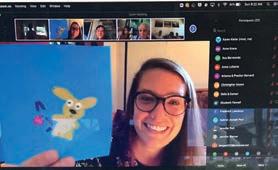

In this “new” world, where so much of our spiritual lives had to move online, we’ve been powerfully reminded how much we need one another and how significant it is to gather in person. But many parish ministries are not just surviving through this medium, they’re thriving. In fact, people of all ages are participating in digital faith sharing, and real community is formed in these digital spaces.
One might be inclined to prioritize either digital media or in-person gatherings. Instead, leaders should explore best practices for integrating digital communities into our physical realities one ministry at a time. While there is no universal, one-size-fits-all solution, these four best practices can help integrate the digital and traditional aspects of your faith community.
BE WITH YOUR PEOPLE
Good parish communication starts with a question: “Where is the best place to reach you?” For some groups, that might mean age-old, tried-and-true communication methods—the parish bulletin, a poster in the church hall, or an email newsletter. Other groups might need something more sophisticated such as a WhatsApp or Facebook group or a digital content management space like Trello or Slack. It depends on with whom you’re trying to communicate, how often you’re trying to communicate, and how engaged you’d like them to be. Go to where people are and communicate there.
After understanding what media work best for your community, it’s important to define your goals. Are you trying to invite the entire parish to a particular event or ministry? Are you trying to reach people who aren’t in the pews? Or are you simply trying to share an update with your group? Too often, parishes try to do all of their communication on just one platform. In these days of digital connectivity, that doesn’t work. You have to know the ins and outs of your audience before you can do anything else.

BE CONSISTENT
Using a platform that is foreign to you can be challenging, but communicating consistently covers a multitude of ills. Even before the pandemic, parishioners accustomed to on-demand information were rigorous in their quests to find answers to questions. Your parish can best serve those parishioners by establishing an explicit standard of communication. Create a culture that emphasizes quick and concise responses and clearly outline how often people can expect to hear from you. For instance, if a parish youth group primarily communicates through WhatsApp, youth ministers should set intervals at which participants can expect updates. If you’re a pastor, set aside one day each week to issue a video or column on social media so people know when they can expect to see an update from you. Never let the lines of communication go dead, especially if your chosen method is digital. Be available if someone has a question. If people see others asking questions and getting responses, they will feel more comfortable asking you what is on their hearts.
BE PRESENT
Communication is first a ministry of presence. Sometimes people don’t want or need resources. Sometimes they don’t want to be hassled with asks about events or donations. Sometimes communicating in your parish is simply about being there for people in their times of need. For instance, a bereavement ministry might find that a private Facebook group is the best way for its members to communicate and gather. While it’s important to share updates about meeting times and prayer requests, your ministry will bear more fruit if you focus on creating space for people to gather that is safe and welcoming, where people can interact without judgment, and where people can grow with one another. Social media, when used properly, can be a wonderful and dialogical space for ministries of accompaniment.
BE ENGAGING
The digital age has radically redefined communication at every level, flooding the market with content of all kinds. To cut through the noise, you have to create engaging and original content on whatever medium you select. If social media is your chosen avenue to interact with the parish at large, quality video content is a must. If you want to effectively communicate in digital groups on Facebook, WhatsApp, or similar sites, beautiful graphics will draw people’s attention when they scroll through their feeds.
It’s not enough to just create good content. Any parish communicator is at their most effective when they ask questions, invite feedback, and encourage sharing from their parishioners and group members. “Being engaging” can be as simple as asking for feedback via Google forms after an event or asking a question on social media. Digital media certainly makes our world noisy, but it also gives us the unprecedented ability to engage with and hear others.
Communication is about community, and the digital tools at our disposal allow us to cultivate communities, whether it’s the parish as a whole, ministries, or leadership. The actual platform or medium you use will differ from community to community. Working with digital tools can be overwhelming, but if you remember these best practices and keep your communication fixed on Jesus, you’ll communicate in this noisy, difficult world. After all, there is no message more engaging than the Gospel, nobody more present to us than Jesus, and no institution capable of communicating as effectively as the Church when we move forward with faith, transparency, and compassion. ■
This article was originally published in the August 2021 issue of U.S. Catholic (Vol. 86, No. 8) and is reprinted with permission (uscatholic.org).
Celebrating 20 Years | ANNIVERSARY ISSUE 39
John T. Grosso, BC ’14, is the director of digital media for the Diocese of Bridgeport, Connecticut.
THE CHURCH IN THE 21ST CENTURY CENTER RESOURCES

Available to parishes, schools, and individuals everywhere—all complimentary and accessible online.
The hallmark publication of the C21 Center, offering articles and resources to support the key challenges facing the Church today.
A faith conversation program for all ages (in-person or virtual), supported by themed guides.

A caffeinated faith storytelling program for teens/ young adults in colleges, high schools, and parishes.
A parish model that invites 20- and 30-somethings to attend Mass, followed by a one-hour social hangout.

A faith podcast conversation series on the C21 Center website or through your preferred platform.



A 15-minute, online, weekly prayer program hosted by the C21 Center, open to everyone.

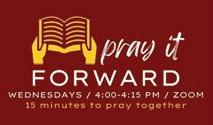
Tools and research for capturing student input on faith.
A creative children's faith formation program for the home, classroom, or parish, supported by themed guides.
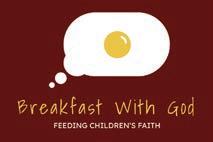
CENTER
Explore the full collection of videos from C21 Center conversations, programs, and events

visit bc.edu/c21 or follow us on social media @c21center acebookkkk the church in the 21st century center | boston college | 110 college rd. | chestnut hill, ma 02467 non-profit organization u.s. postage paid boston, massachusetts permit no. 55294
magazine
















































































 Casey Beaumier, S.J.
Casey Beaumier, S.J.












 Hosffman Ospino
Hosffman Ospino
















 Thomas Groome
Thomas Groome



















 Fr. Michael J. Himes
Fr. Michael J. Himes















